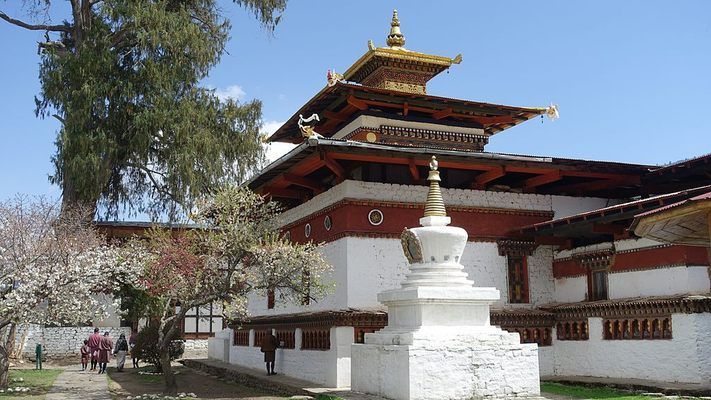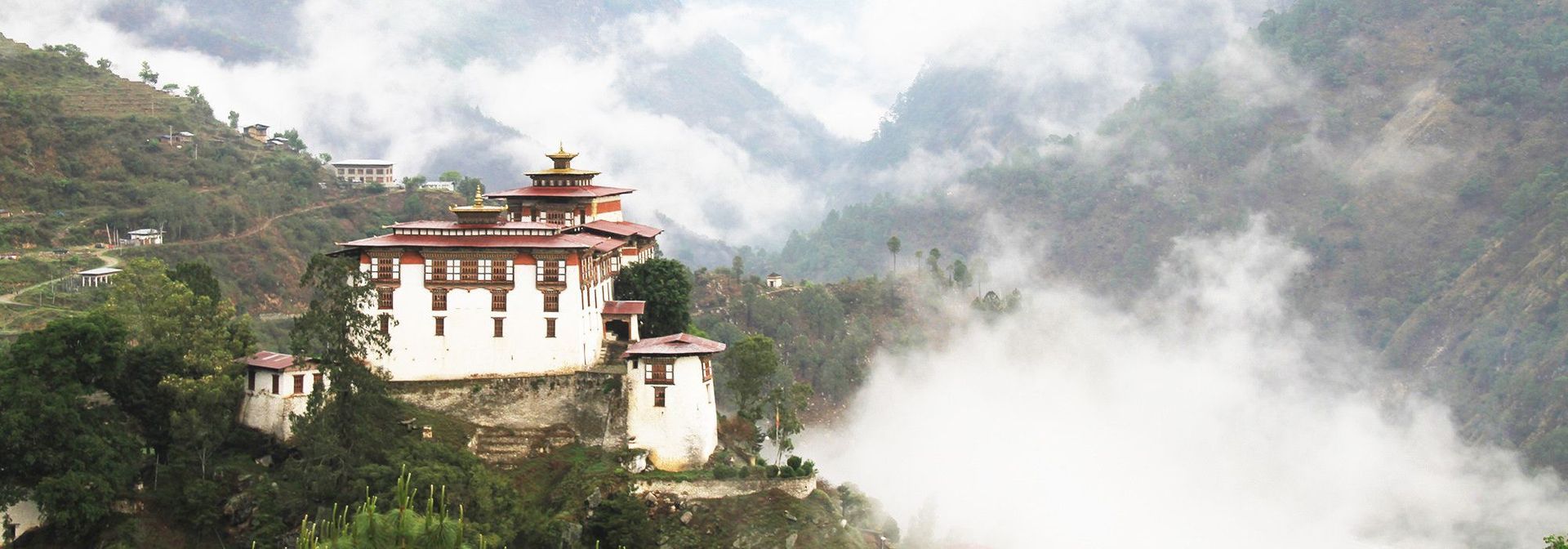Paro: Cultural Heritage and Scenic Bliss Experience
Paro, a charming valley town, is a treasure trove of Bhutanese culture and natural beauty. Known for its serene landscapes, iconic monasteries, and ancient fortresses, it offers a gateway to Bhutan’s spiritual and adventurous heart. Paro’s blend of cultural heritage and breathtaking scenery promises an unforgettable experience.
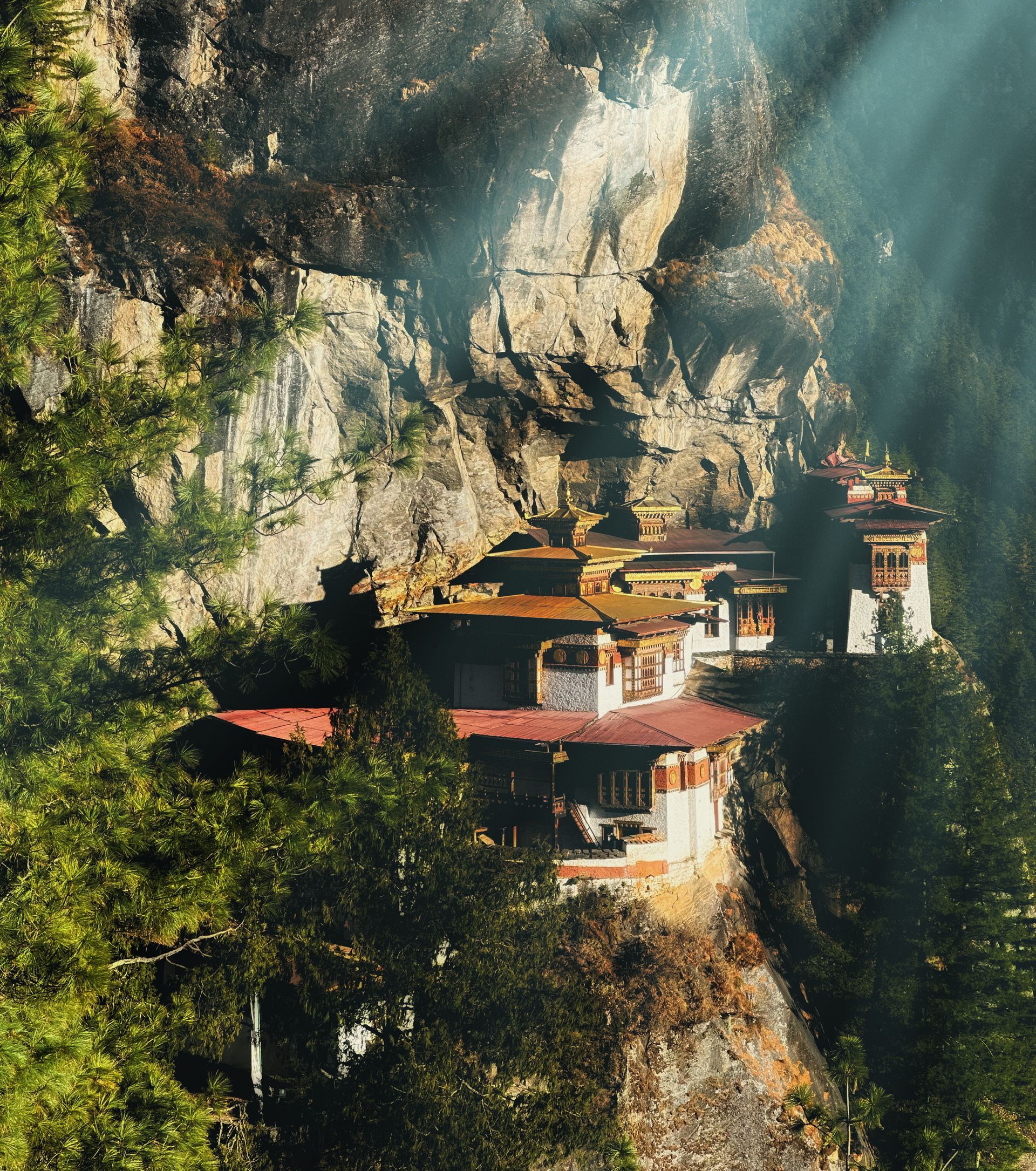
Tiger’s Nest Monastery (Paro Taktsang)
Activity:
Trek to Bhutan’s most iconic monastery.
Details:
Perched on a 900-meter cliffside, Paro Taktsang is a symbol of spiritual devotion and resilience. The trek begins through dense pine forests, where prayer flags line the paths, symbolizing blessings. Halfway, a teahouse offers a perfect spot to rest and enjoy scenic views of the monastery. Reaching the monastery, visitors are greeted by ornate interiors and rich Buddhist iconography.
Kyichu Lhakhang
Activity: Visit one of Bhutan’s oldest temples.
Details: Built in the 7th century by Tibetan King Songtsen Gampo, Kyichu Lhakhang is a serene and sacred place. The temple is adorned with prayer wheels and vibrant floral gardens. Pilgrims and tourists alike find solace in its tranquil environment and deep historical significance.
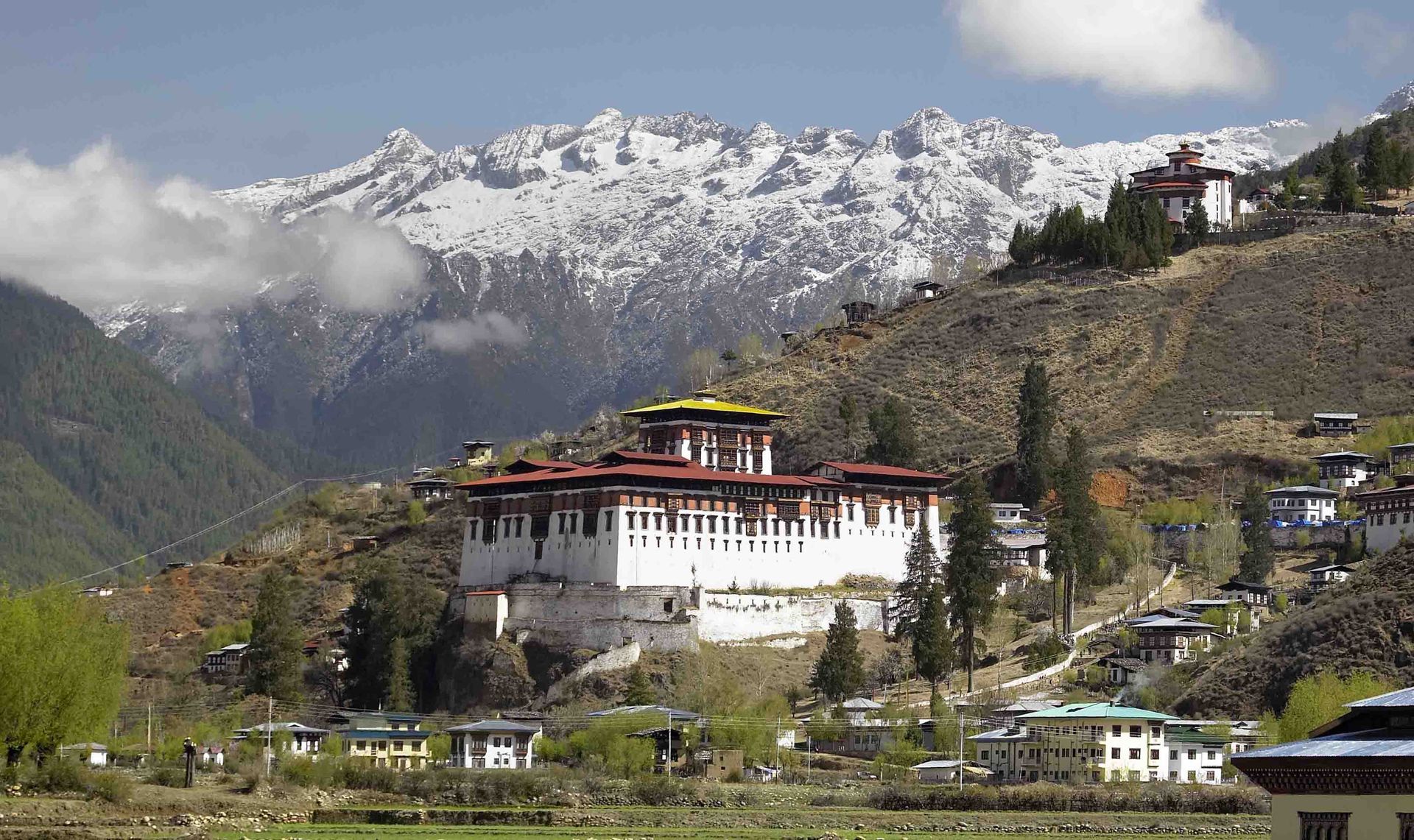
Rinpung Dzong and Ta Dzong (National Museum)
Activity: Explore a historic fortress of Bhutan.
Details: Built in the 17th century, Rinpung Dzong is an architectural masterpiece that played a key role in Bhutan’s defense. Visitors can cross the traditional wooden cantilever bridge to enter the fortress, which now houses monastic institutions and administrative offices. The dzong’s intricately painted murals and stunning valley views make it a must-visit.
Chele La Pass
Activity: Journey to Bhutan’s highest motorable pass.
Details: Located at an altitude of 3,989 meters, Chele La Pass offers breathtaking views of Mount Jomolhari and the Haa Valley. The drive to the pass takes visitors through lush rhododendron forests and rolling hills. Upon arrival, colorful prayer flags flutter in the wind, creating a serene and spiritual ambiance.


Ta Dzong (National Museum)
Activity: Discover Bhutan’s cultural heritage.
Details: Formerly a watchtower, Ta Dzong now houses the National Museum of Bhutan. Its exhibits include ancient artifacts, traditional weapons, Thangka paintings, and natural history displays. The museum provides a comprehensive insight into Bhutanese art, culture, and history.
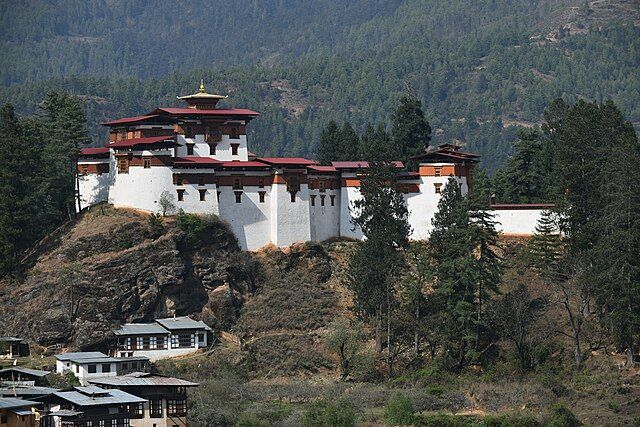
Drukgyel Dzong
Activity: Step into Bhutan’s historical legacy.
Details: Drukgyel Dzong was constructed in 1647 to commemorate Bhutan’s victory over Tibetan invaders. Though partially in ruins, it remains a symbol of Bhutanese resilience. On clear days, visitors can enjoy stunning views of Mount Jomolhari from the site.
Traditional Farmhouse Visit
Activity: Experience rural Bhutanese life.
Details: A visit to a traditional farmhouse offers a glimpse into Bhutanese agrarian culture. Guests can participate in activities like butter-churning, preparing traditional meals, and archery. The experience often concludes with a rejuvenating hot stone bath, a therapeutic Bhutanese tradition.
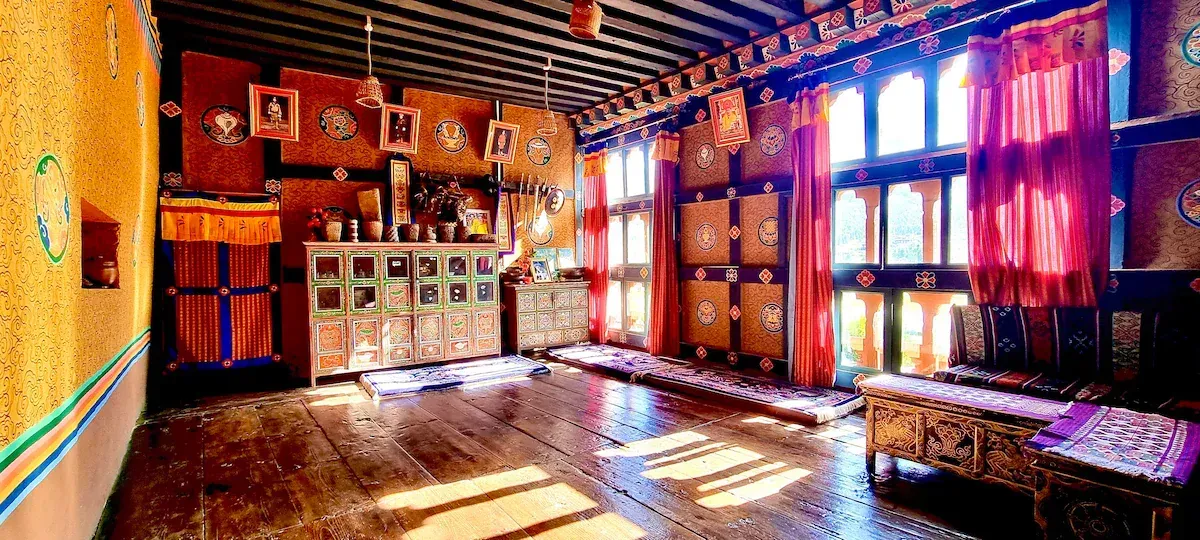
Dumtse Lhakhang
Activity: Explore a unique chorten-shaped temple.
Details: Built by Thangtong Gyalpo in the 15th century, Dumtse Lhakhang is a spiritual treasure. The temple’s three floors represent heaven, earth, and hell, and its walls are adorned with intricate murals depicting Buddhist cosmology.

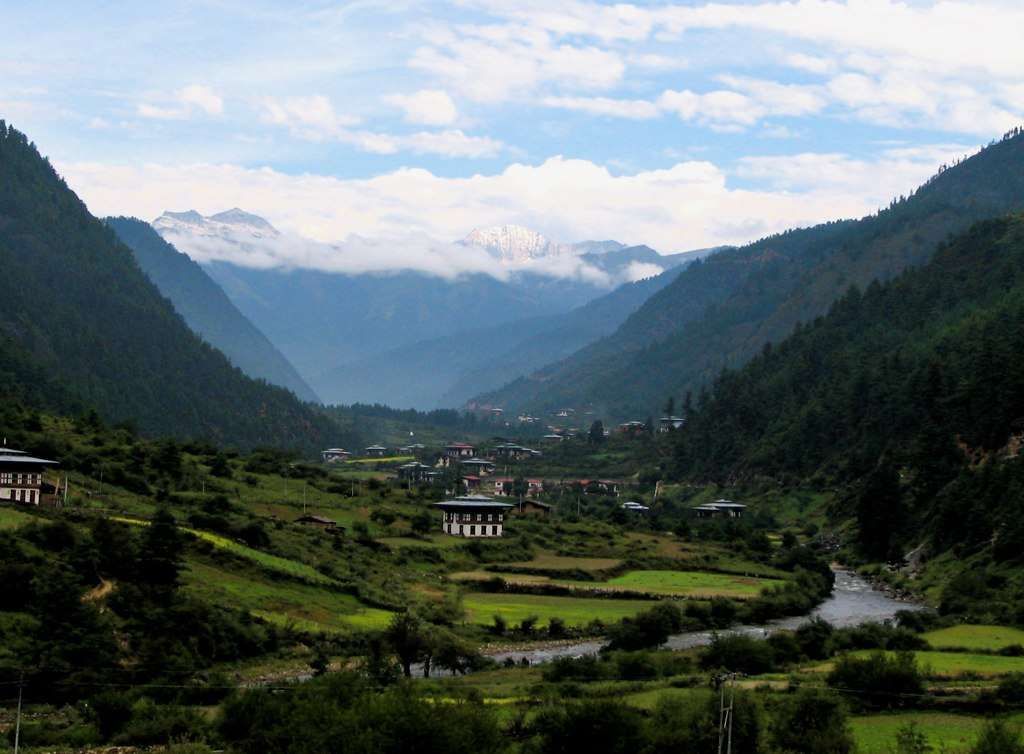
Haa Valley Excursion (Optional)
Activity: Take a day trip to the pristine Haa Valley.
Details: Just a short drive from Paro, the Haa Valley offers unspoiled natural beauty and a rich cultural experience. Visitors can explore Lhakhang Karpo (White Temple) and Lhakhang Nagpo (Black Temple), stroll through serene villages, and enjoy a picnic by the riverside.
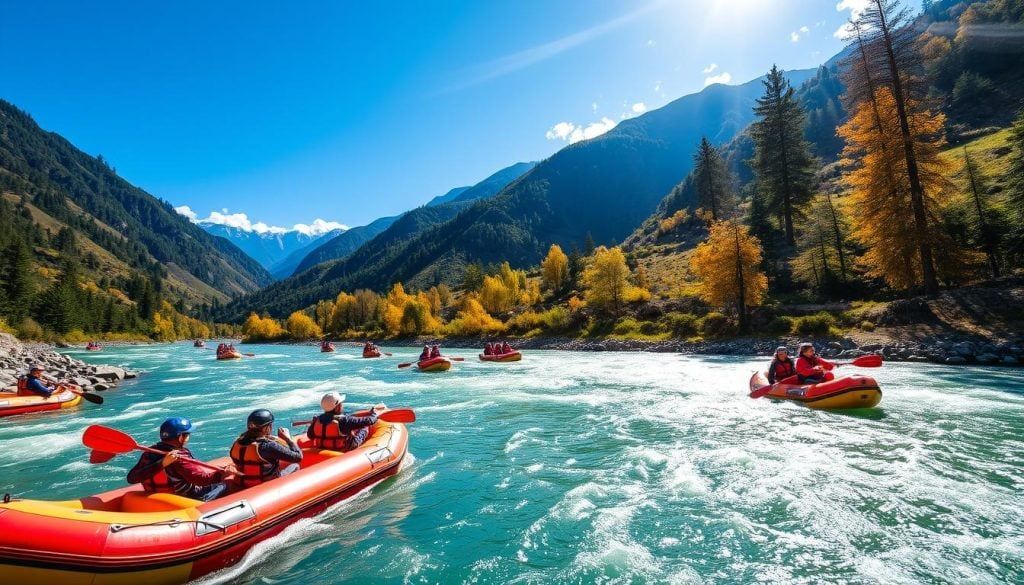
Riverside Picnics or Rafting (Seasonal)
Activity: Relax or adventure by the Paro Chhu.
Details: Visitors can unwind with a picnic along the scenic riverbanks or enjoy a thrilling rafting experience on the gentle rapids of Paro Chhu. These activities provide a perfect blend of relaxation and adventure in nature.
Contact Us
We will get back to you as soon as possible.
Please try again later.
Thimphu: A Blend of Tradition and Modernity
Thimphu, Bhutan’s bustling capital, is a unique city that blends rich cultural traditions with modern lifestyle. Nestled in a scenic valley, it offers visitors an opportunity to explore Bhutanese heritage, art, governance, and nature, all within a harmonious urban setting. From grand fortresses to serene hikes, Thimphu is a treasure trove of experiences.
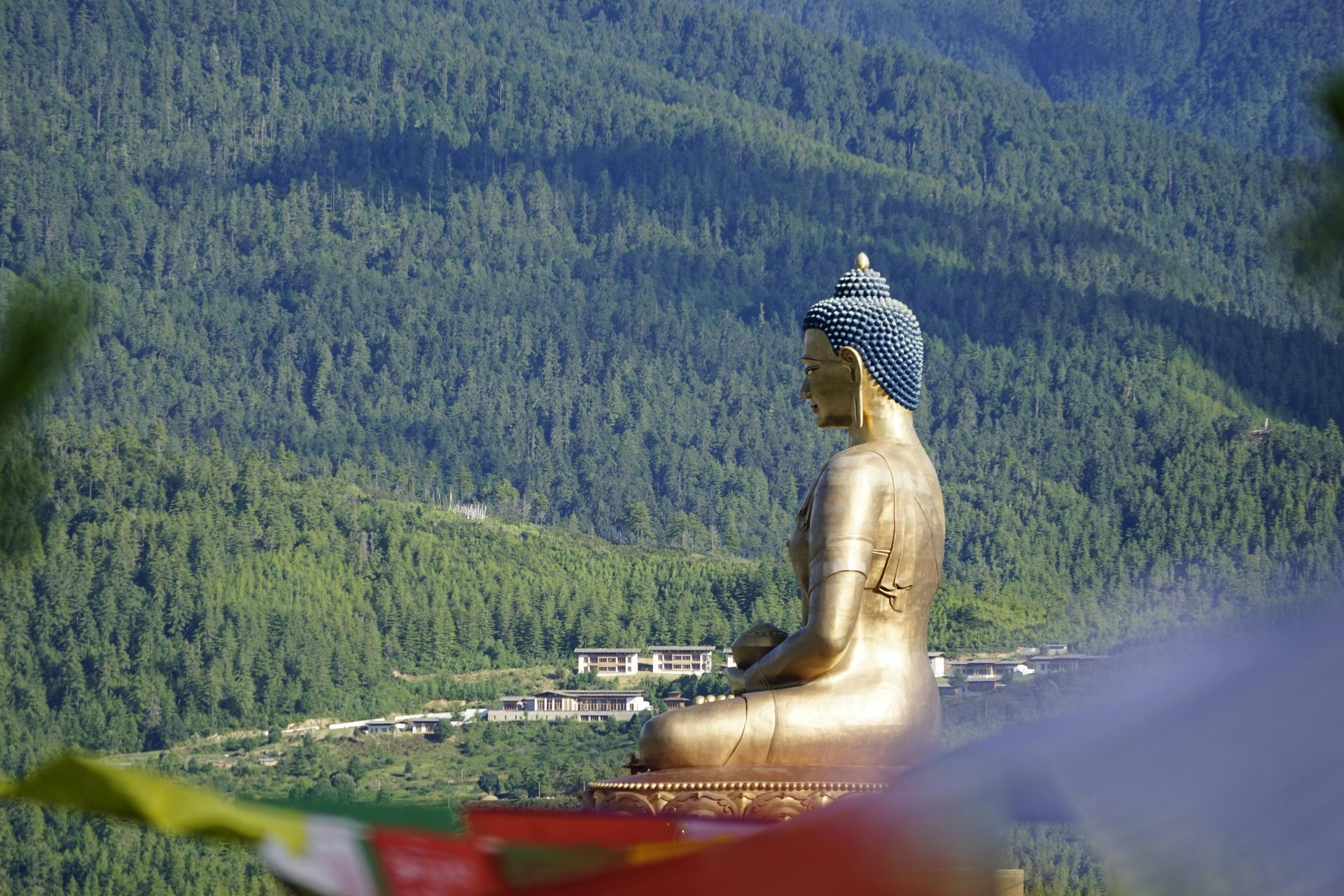
Buddha Dordenma Statue
Activity: Marvel at one of the world’s largest Buddha statues.
Details: Towering at 51.5 meters, the Buddha Dordenma Statue is an iconic landmark overlooking the Thimphu valley. Made of bronze and gilded in gold, the statue houses thousands of smaller Buddha statues and offers panoramic views of the valley. The surrounding trails provide opportunities for peaceful hikes amidst nature.
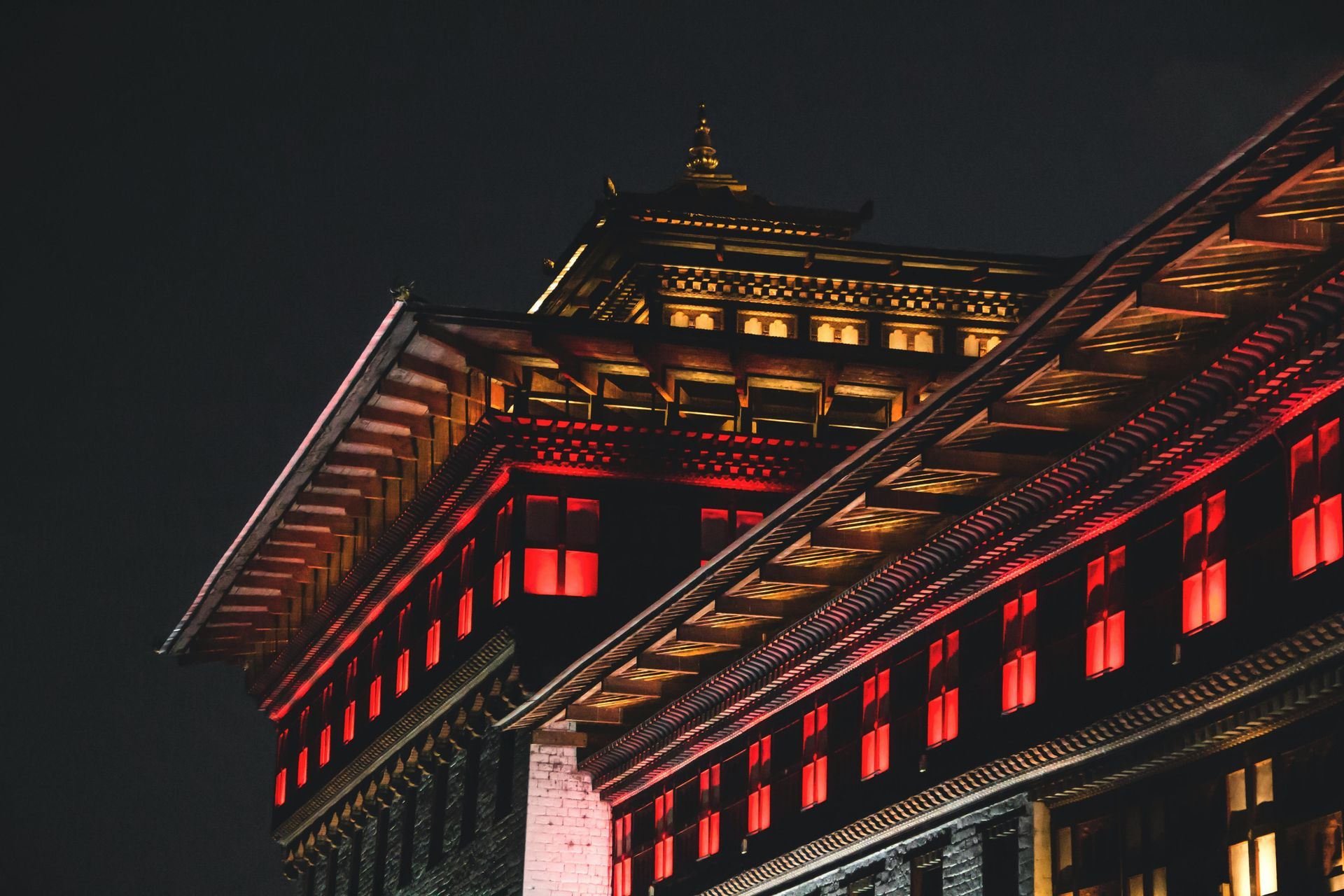
Tashichho Dzong
Activity: Visit Bhutan’s seat of governance and monastic life.
Details: Known as the “Fortress of the Glorious Religion,” Tashichho Dzong is an impressive structure that houses the throne room of the King and the summer residence of the monastic body. The beautifully landscaped gardens and intricate architecture make it a must-visit destination. Evening guided tours are available to enhance the experience.
Memorial Chorten
Activity: Pay homage at a revered stupa.
Details: Built in 1974 in memory of the Third King of Bhutan, the Memorial Chorten is a spiritual hub where locals gather to pray and circumambulate. The whitewashed stupa, adorned with golden spires and vibrant gardens, is a serene spot for reflection and cultural immersion.
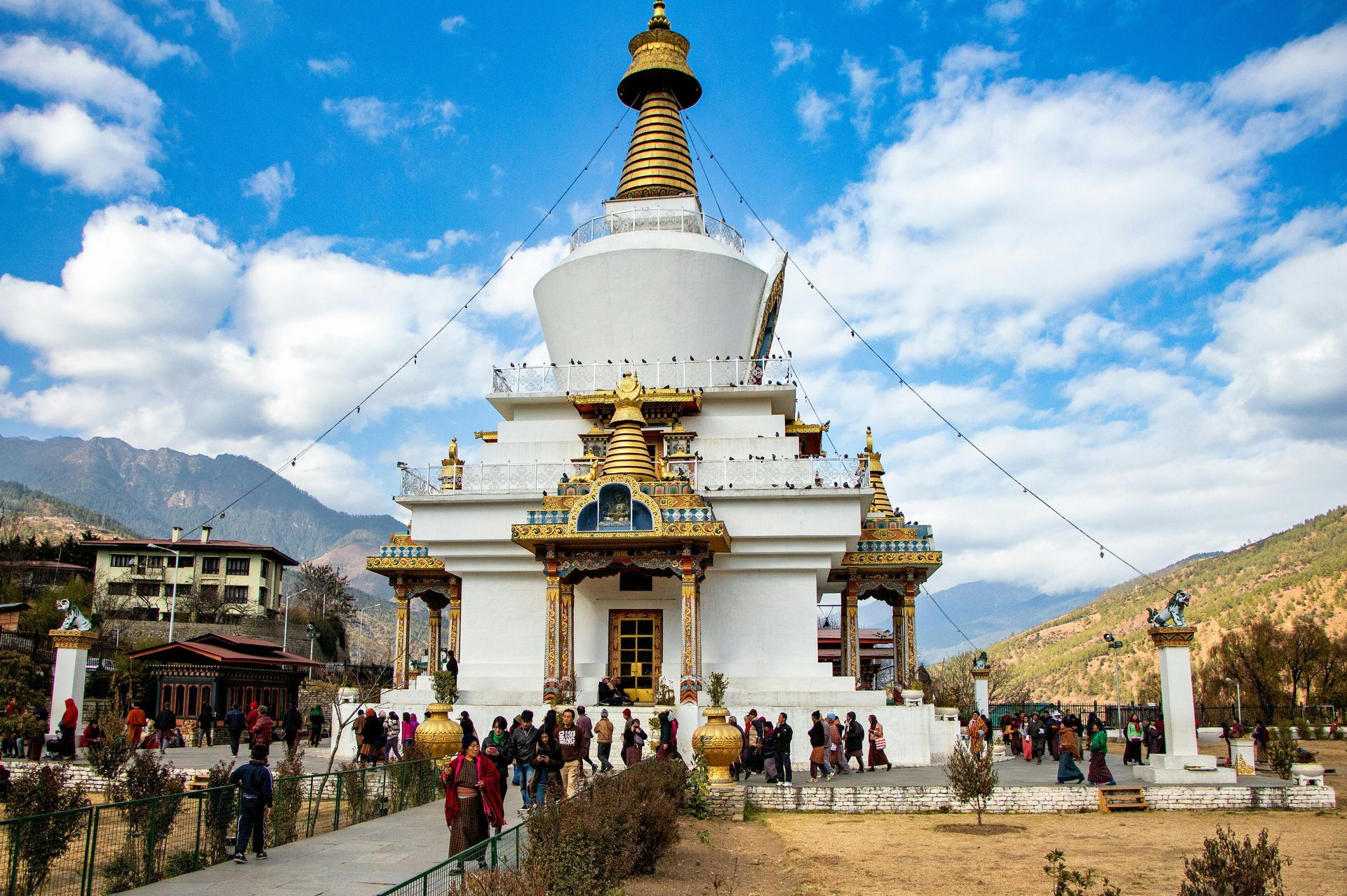
Folk Heritage Museum
Activity: Step back in time to rural Bhutanese life.
Details: This traditional farmhouse museum offers insights into Bhutan’s rural lifestyle, showcasing tools, household items, and farming practices. Visitors can experience seasonal activities such as rice planting or butter churning, adding an interactive element to the visit.
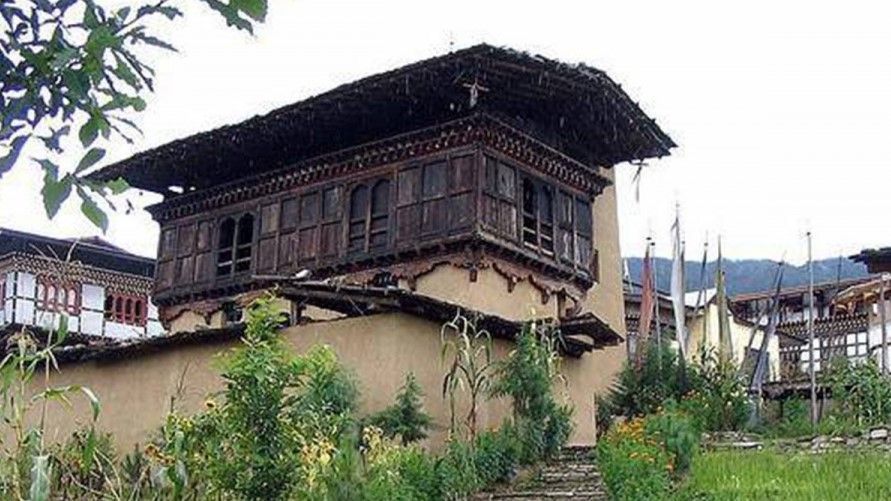
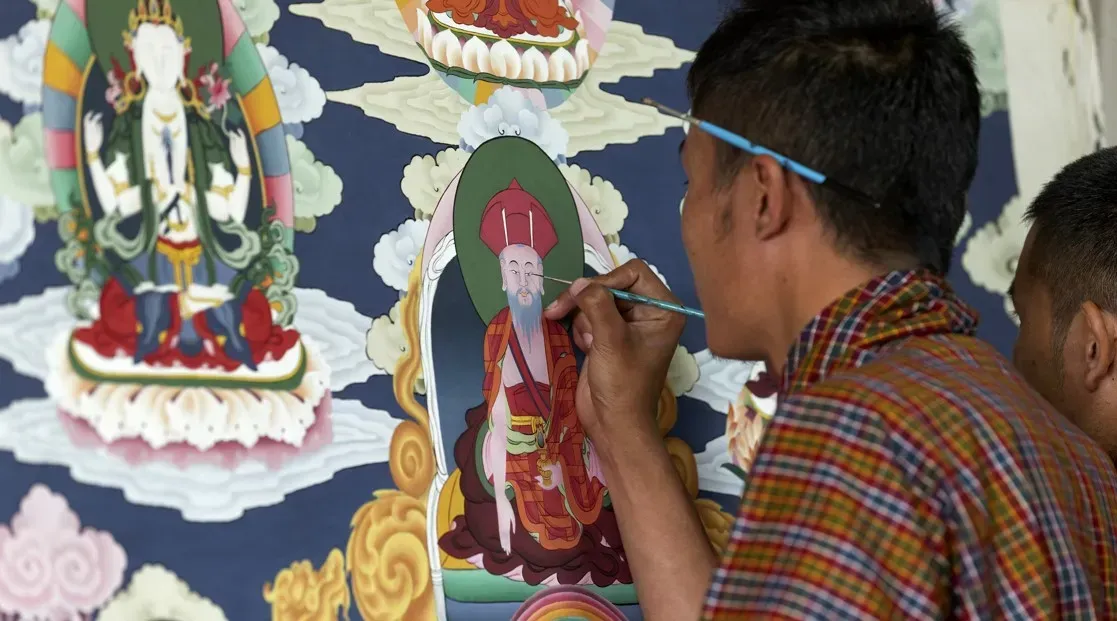
National Institute for Zorig Chusum
Activity: Witness the making of Bhutanese art.
Details: Also known as the Painting School, this institute trains students in Bhutan’s 13 traditional arts and crafts. Visitors can observe students practicing skills such as thangka painting, wood carving, and embroidery, providing a deeper appreciation for Bhutanese artistry.

Changangkha Lhakhang
Activity: Visit Thimphu’s oldest temple.
Details: Perched on a hill overlooking the city, Changangkha Lhakhang is a sacred site for blessings, especially for newborns. The temple features beautiful murals, prayer wheels, and a central statue of Chenrezig, the Compassionate Buddha.
Simtokha Dzong
Activity: Explore the oldest dzong in Bhutan.
Details: Built in 1629, Simtokha Dzong is a historic fortress that now houses a Buddhist language and cultural studies institute. Its ancient murals and intricate carvings make it a fascinating cultural landmark.
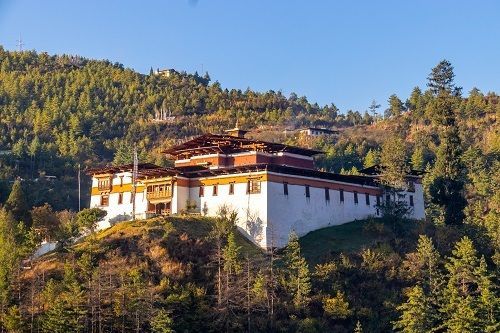
Weekend Market
Activity: Shop like a local.
Details: Open from Friday to Sunday, the Weekend Market is a lively spot where vendors sell fresh produce, spices, handmade crafts, and textiles. It’s an excellent place to taste local snacks, mingle with locals, and purchase unique souvenirs.


Bhutan Postal Museum
Activity: Create personalized postage stamps.
Details: The Postal Museum showcases Bhutan’s postal history, including the famous talking stamps. Visitors can design custom stamps with their photos, making for a unique and memorable souvenir.

Dochula Pass
Activity: Take a day trip to a scenic mountain pass.
Details: Located 30 minutes from Thimphu, Dochula Pass offers breathtaking views of the Himalayan range. The site is home to 108 Druk Wangyal Chortens, built in honor of Bhutanese soldiers. Visitors can enjoy the serene atmosphere and explore nearby trails.
Takin Preserve
Activity: Meet Bhutan’s national animal.
Details: This wildlife preserve is home to the takin, a rare and unique animal found only in Bhutan. Visitors can learn about the legend behind the takin’s creation while observing these fascinating creatures in their natural habitat.
Side Trip: Sangaygang Thimphu city view point.
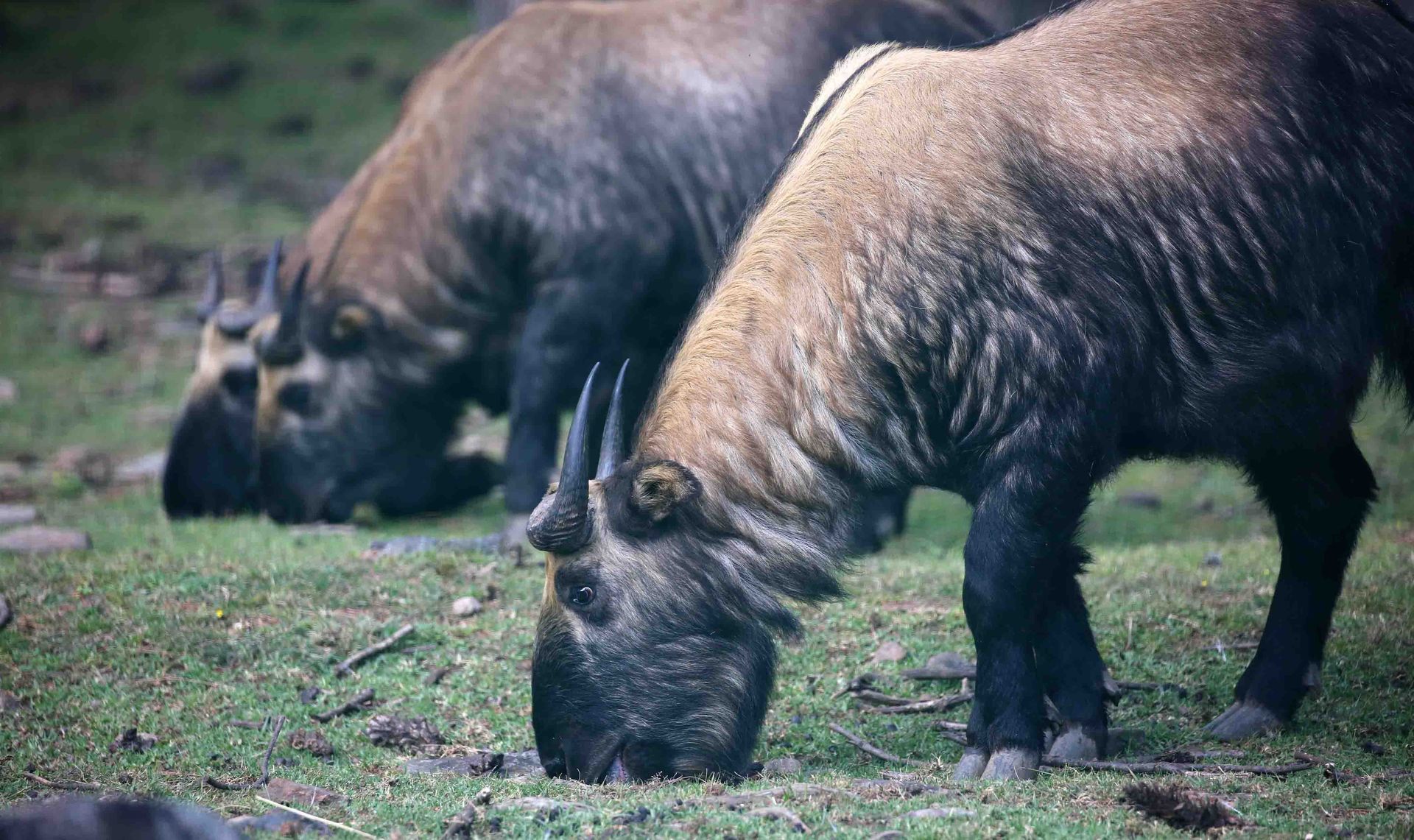
Traditional Archery Ground
Activity: Experience Bhutan’s national sport.
Details: Archery is a celebrated sport in Bhutan, and visitors can watch skilled archers demonstrating their prowess at a traditional archery ground. You can even try your hand at archery under expert guidance.

Punakha: The Enchanting Valley of Bliss
Punakha, the ancient capital of Bhutan, is renowned for its stunning landscapes, sacred monasteries, and historical significance. Nestled at the confluence of the Pho Chhu and Mo Chhu rivers, this fertile valley offers a harmonious blend of natural beauty and cultural heritage. Often referred to as Bhutan’s winter retreat, Punakha provides visitors with spiritual landmarks and serene rural settings.

Punakha Dzong (The Palace of Great Bliss)
Activity: Visit Bhutan’s most iconic fortress.
Details: Constructed in 1637, Punakha Dzong is a masterpiece of Bhutanese architecture. Situated at the confluence of the Pho Chhu and Mo Chhu rivers, the fortress is adorned with intricate wood carvings and vibrant murals. It served as the coronation site of Bhutan’s kings and remains the winter residence of the central monastic body. Visitors can explore its grand halls and scenic surroundings.
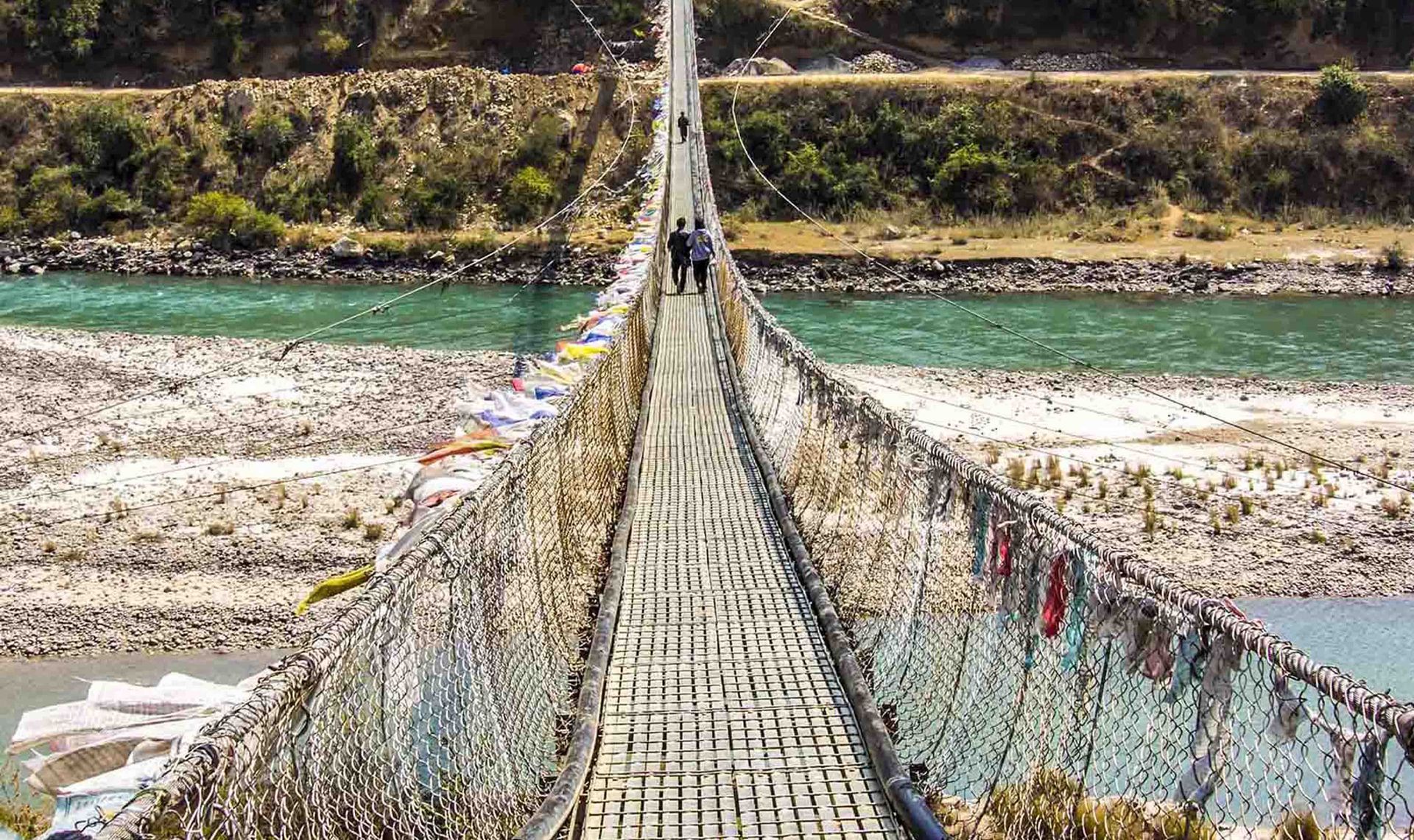
Suspension Bridge Over Pho Chhu River
Activity: Walk across Bhutan’s longest suspension bridge.
Details: Spanning 160 meters, this suspension bridge connects the dzong to nearby villages. Draped with colorful prayer flags, it offers breathtaking views of the river and valley below. Walking across the bridge provides both a thrilling and serene experience.
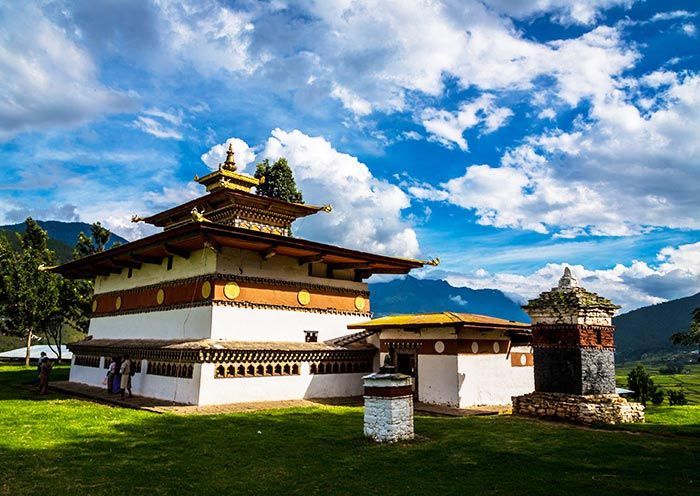
Chimi Lhakhang (The Fertility Temple)
Activity: Seek blessings at a revered temple.
Details: Built in 1499 by the Divine Madman, Lama Drukpa Kunley, Chimi Lhakhang is a pilgrimage site for couples seeking fertility blessings. A short hike through scenic paddy fields leads to the temple, where visitors can learn about Bhutan’s unique spiritual traditions and enjoy the peaceful ambiance.
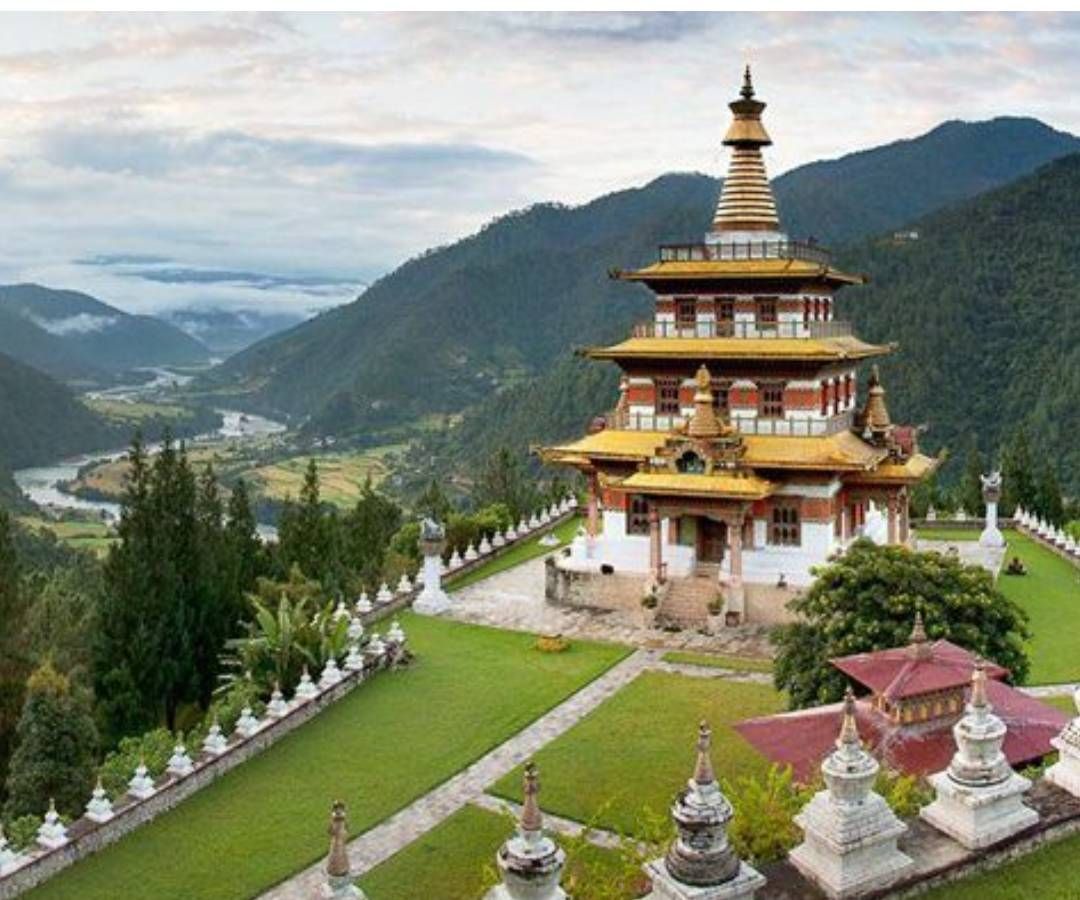
Khamsum Yulley Namgyal Chorten
Activity: Hike to a sacred hilltop stupa.
Details: This stunning stupa, built to bring peace and harmony, sits atop a hill overlooking the Punakha valley. The hike takes approximately one hour through terraced fields and forested trails. At the summit, visitors are rewarded with mesmerizing views of the valley and surrounding mountains.
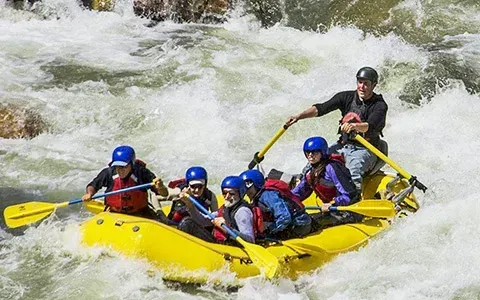
Mo Chhu River Rafting
Activity: Enjoy an exhilarating river rafting experience.
Details: The Mo Chhu river offers calm yet adventurous rafting opportunities suitable for all skill levels. The journey includes gentle rapids and serene stretches, passing by scenic farmlands and providing unique views of Punakha Dzong from the water.

Punakha Festival (Optional)
Activity: Witness Bhutan’s vibrant cultural celebration.
Details: Held annually in February or March, the Punakha Tshechu features traditional mask dances, folk songs, and religious ceremonies. It commemorates historical events and serves as a spiritual gathering for locals. Visitors can enjoy the festive atmosphere and connect with Bhutan’s rich cultural traditions.

Talo and Nobgang Villages
Activity: Discover Punakha’s traditional lifestyle.
Details: These picturesque villages are known for their terraced farms, traditional houses, and tranquil surroundings. Talo is the ancestral home of Bhutan’s royal family. Visitors can stroll through the villages, interact with locals, and immerse themselves in Bhutanese rural life.
Sangchhen Dorji Lhuendrup Nunnery
Activity: Visit a serene nunnery with panoramic views.
Details: Perched on a hill overlooking the valleys of Punakha and Wangdue Phodrang, this nunnery is both a religious center and a school for nuns. The site features a large bronze statue of Avalokiteshvara, intricate murals, and peaceful gardens, offering a tranquil retreat for visitors.
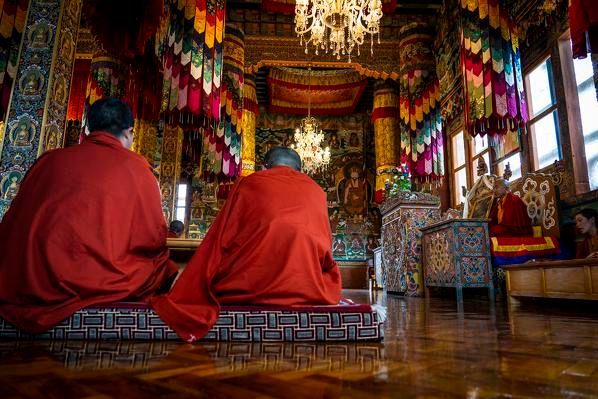
Dochula to Punakha Scenic Drive
Activity: Enjoy the scenic journey from Dochula Pass to Punakha.
Details: The drive descends through lush forests, offering glimpses of waterfalls and vibrant flora. The route provides a stark contrast to the high-altitude landscapes of Dochula Pass, transitioning into the subtropical warmth of Punakha valley.
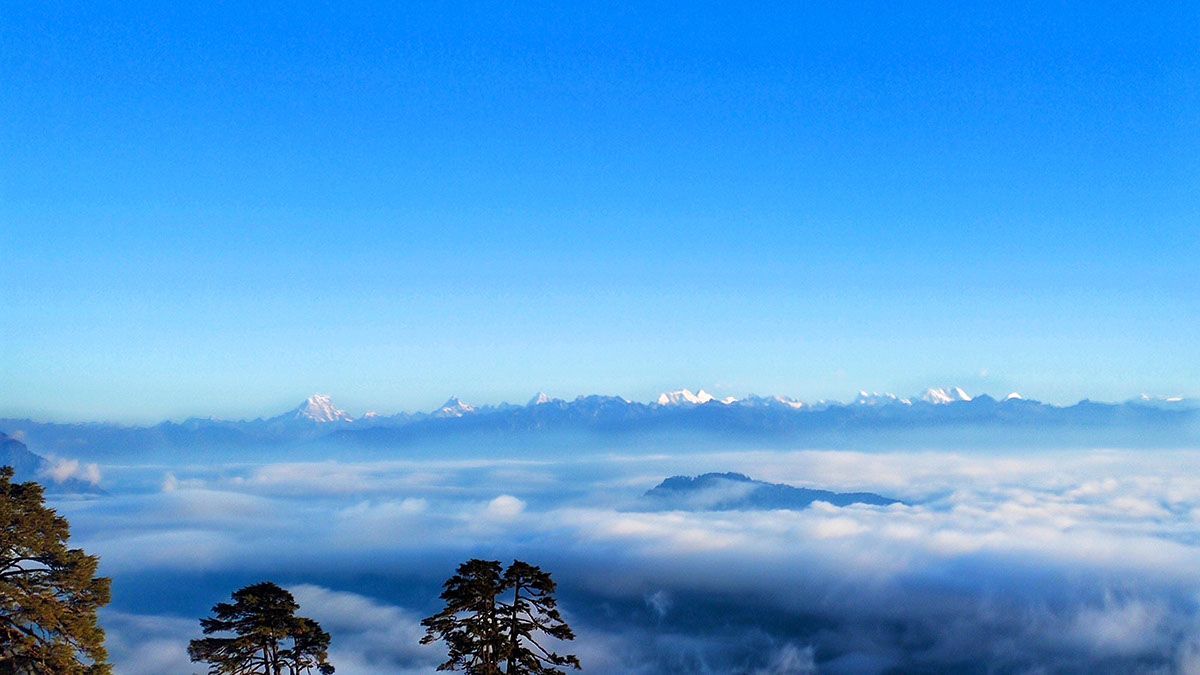
Bumthang: The Spiritual Heartland of Bhutan
Bumthang, often referred to as Bhutan’s spiritual heartland, is home to some of the country’s oldest temples and monasteries. Nestled in a lush valley, Bumthang is renowned for its sacred sites, traditional crafts, and serene landscapes. It’s a place where visitors can connect deeply with Bhutanese spirituality and history while enjoying the tranquility of rural life.

Jambay Lhakhang
Activity: Visit one of Bhutan’s oldest temples.
Details: Built in the 7th century by Tibetan King Songtsen Gampo, Jambay Lhakhang is a sacred temple dedicated to Guru Rinpoche. Known for its annual fire dance festival, the temple is an important spiritual site that offers visitors a glimpse into Bhutan’s deep-rooted Buddhist traditions.

Kurjey Lhakhang
Activity: Explore the temple of Guru Rinpoche’s body imprint.
Details: Kurjey Lhakhang is a revered monastery where Guru Rinpoche meditated and left his body imprint on a rock. The site comprises three main temples, each with intricate murals and artifacts. A short walk across a suspension bridge connects visitors to the nearby Tamshing Lhakhang.
Tamshing Lhakhang
Activity: Discover Bhutan’s “Temple of the Good Message.”
Details: Founded in 1501 by Pema Lingpa, Tamshing Lhakhang is a Nyingma monastery known for its sacred murals and spiritual significance. Visitors can explore the temple’s serene interiors and observe monks engaged in daily rituals.
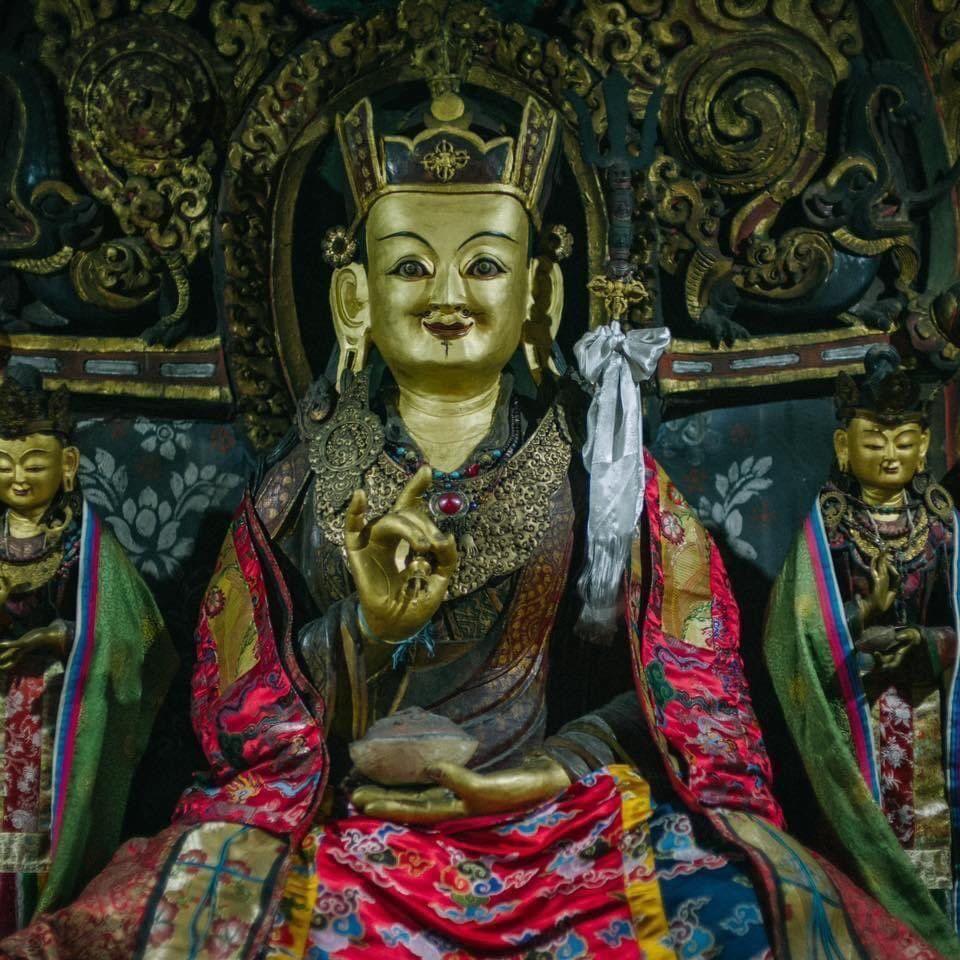
Mebar Tsho (The Burning Lake)
Activity: Visit a sacred pilgrimage site.
Details: Mebar Tsho is a deep, clear lake where the renowned treasure revealer Pema Lingpa is said to have discovered hidden treasures. Surrounded by prayer flags and rocky cliffs, the site exudes a mystical aura, making it a popular spot for meditation and reflection.
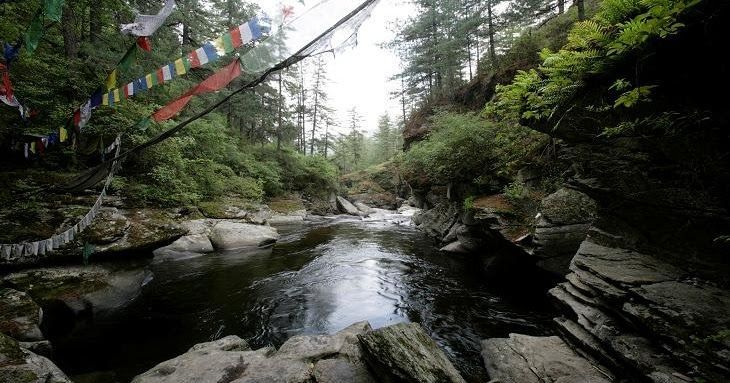
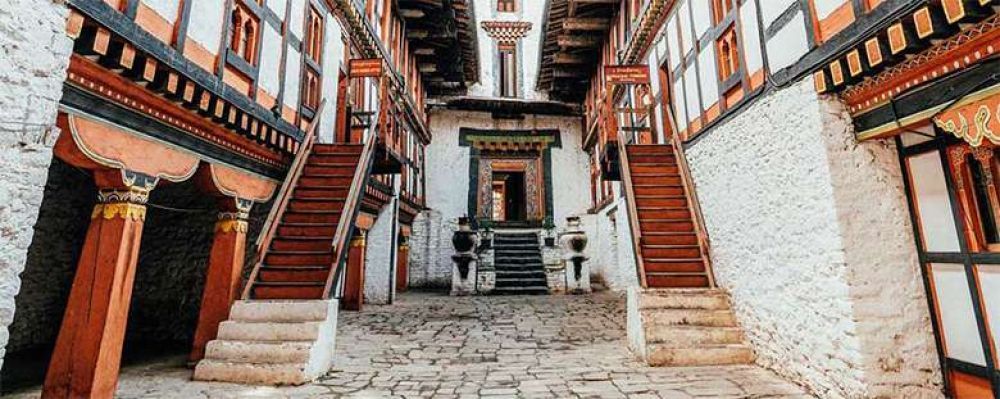
Jakar Dzong
Activity: Explore the “Fortress of the White Bird.”
Details: Overlooking the Bumthang valley, Jakar Dzong is an impressive fortress built in the 17th century. Known for its expansive courtyards and panoramic views, the dzong serves as an administrative and religious center. Visitors can learn about its historical significance while enjoying its serene setting.
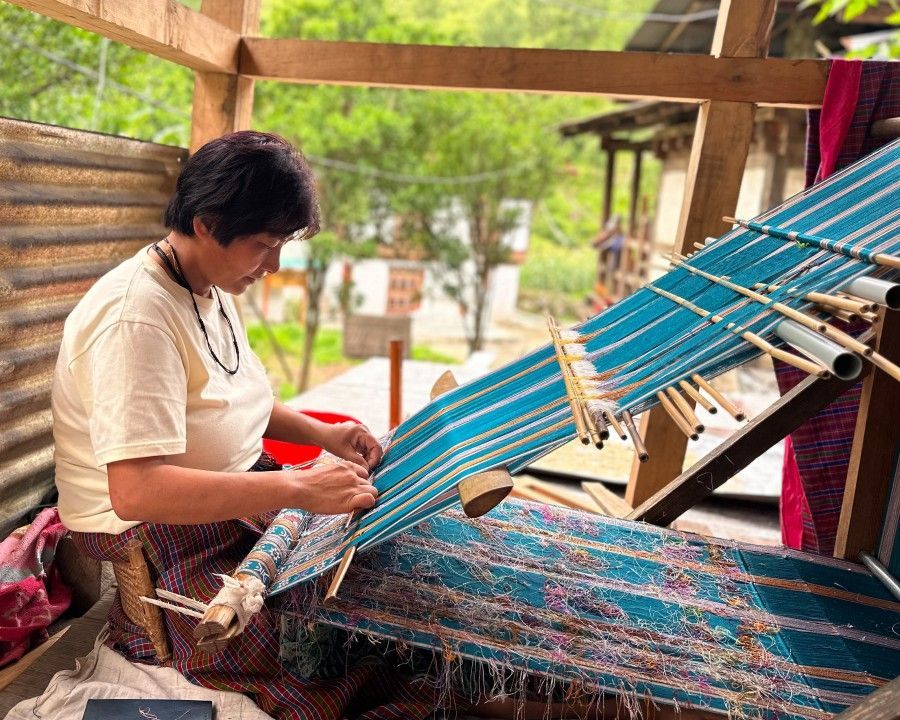
Chumey Weaving Centre
Activity: Witness traditional textile weaving.
Details: Bumthang is renowned for its Yathra textiles, handwoven from sheep wool and dyed with natural pigments. At the Chumey Weaving Centre, visitors can watch artisans at work, learn about the weaving process, and purchase beautifully crafted textiles as souvenirs.
Tang Valley
Activity: Discover a hidden gem in Bumthang.
Details: Tang Valley is a remote and picturesque area dotted with traditional villages, monasteries, and the Ogyencholing Heritage Museum. The museum, a former palace, showcases artifacts and exhibits that provide insights into Bhutan’s cultural and historical heritage. Visitors can enjoy a picnic by the river or hike through the valley’s serene trails.
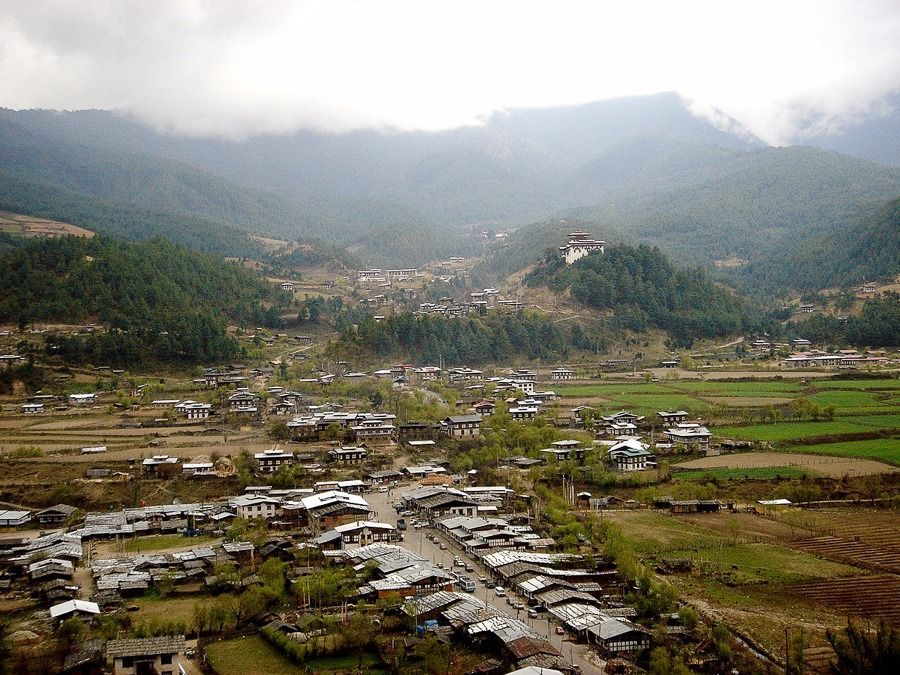
Ura Village
Activity: Experience traditional Bhutanese village life.
Details: Ura Village, located in the eastern part of Bumthang, is known for its cluster of traditional houses and cobblestone paths. Visitors can interact with locals, visit the Ura Lhakhang, and participate in seasonal festivals that showcase Bhutan’s vibrant culture.
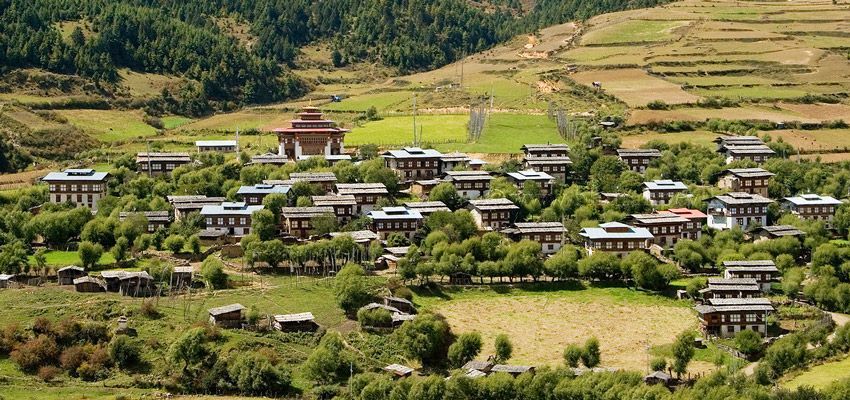
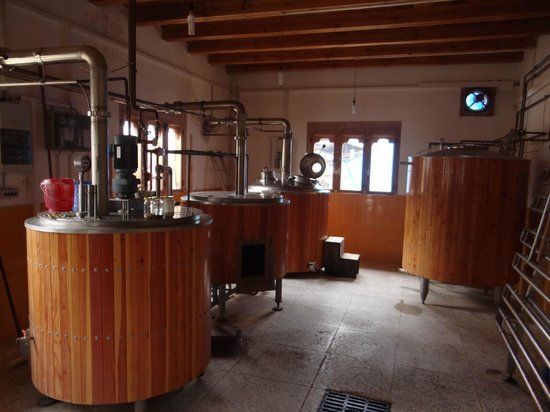
Red Panda Brewery and Swiss Cheese Factory
Activity: Indulge in locally brewed beer and cheese.
Details: Bumthang is home to the Red Panda Brewery, which produces a popular unfiltered wheat beer, and the Swiss Cheese Factory, known for its high-quality cheese products. Visitors can tour the facilities, sample the products, and learn about their production processes.
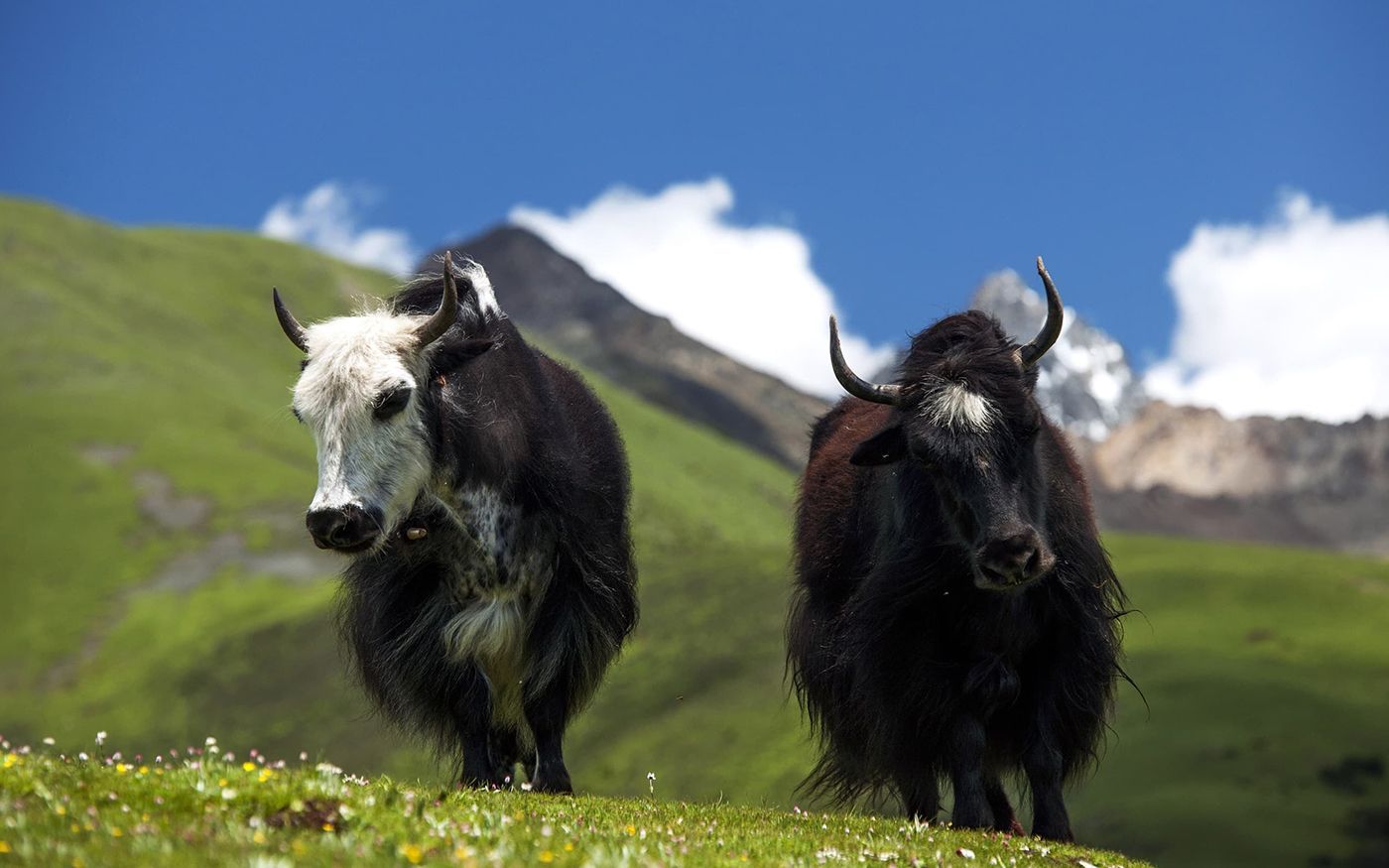
Nature Hikes in Bumthang
Activity: Explore the pristine landscapes.
Details: Bumthang offers numerous trails that meander through forests, fields, and villages. These hikes provide opportunities to experience the region’s natural beauty, spot wildlife, and connect with its serene environment. Popular trails include those around Tang Valley and Kurjey Lhakhang.
Haa: The Hidden Valley of Pristine Beauty
Haa, one of the smallest and least visited districts in Bhutan, is a hidden gem tucked away in the western region. Known for its unspoiled natural beauty, serene villages, and sacred temples, Haa offers a peaceful retreat for those seeking an off-the-beaten-path experience. Surrounded by verdant mountains and rich in history, Haa is a haven for nature lovers and cultural enthusiasts alike.
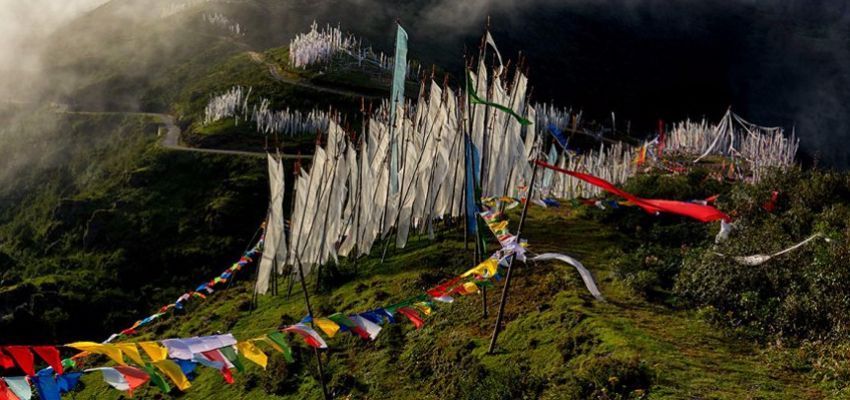
Chele La Pass
Activity: Journey to Bhutan’s highest motorable pass.
Details: At 3,989 meters above sea level, Chele La Pass offers panoramic views of Mount Jomolhari and the Haa and Paro valleys. Visitors can enjoy short hikes, marvel at the vibrant prayer flags, and experience the tranquility of the surrounding alpine landscapes.
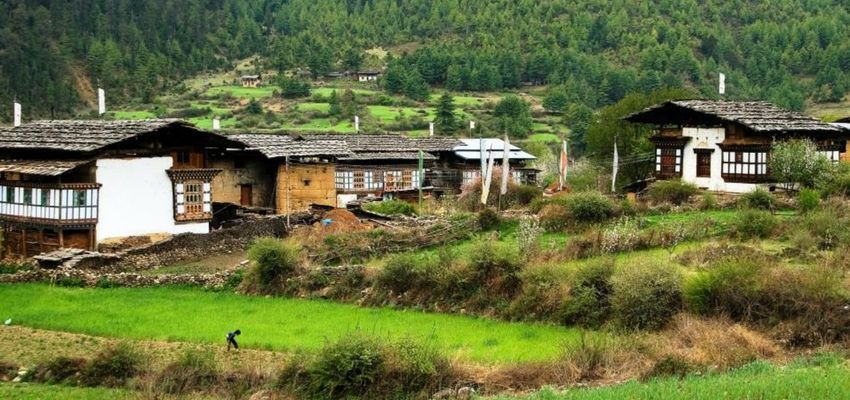
Haa Valley Exploration
Activity: Discover Bhutan’s “Hidden-Land Rice Valley.”
Details: The Haa Valley is a serene expanse of terraced fields, quaint villages, and lush forests. Visitors can stroll through traditional settlements, interact with locals, and learn about their agricultural practices. The valley is especially enchanting during the harvest season.
Lhakhang Karpo and Lhakhang Nagpo
Activity: Visit the “White Temple” and “Black Temple.”
Details: These two sacred temples are steeped in legend and spirituality. Lhakhang Karpo, the White Temple, is known for its pristine architecture, while Lhakhang Nagpo, the Black Temple, exudes a mystical aura. Both temples are set against the backdrop of the majestic Haa Valley, offering a serene and spiritual experience.

Haa Summer Festival (Seasonal)
Activity: Celebrate the unique culture of Haa.
Details: Held annually during the summer, the Haa Summer Festival is a vibrant celebration of the valley’s traditional lifestyle. Visitors can witness colorful performances, sample local cuisine, and participate in activities such as yak riding and traditional games.

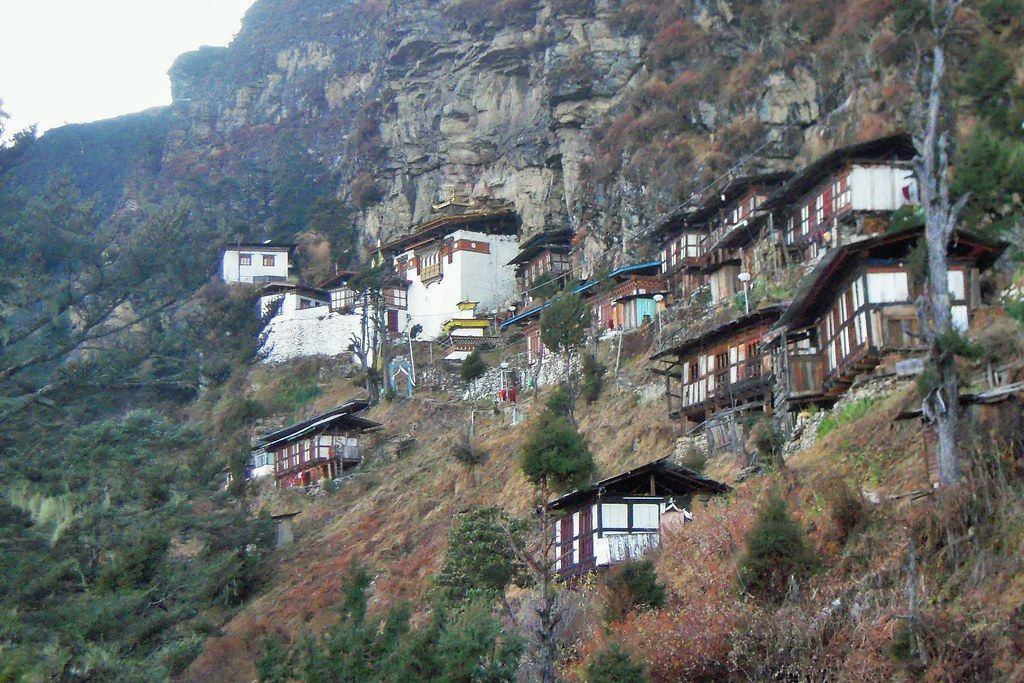
Kila Gompa Nunnery
Activity: Explore a serene cliffside nunnery.
Details: Located en route to Haa from Paro, Kila Gompa is one of Bhutan’s oldest nunneries. Perched on a steep cliff, it is home to meditating nuns and offers breathtaking views of the surrounding valleys. Visitors can enjoy a peaceful walk through the area and learn about the nuns’ way of life.

Traditional Farmhouse Visit
Activity: Experience rural Bhutanese hospitality.
Details: A visit to a traditional farmhouse in Haa allows visitors to immerse themselves in the local way of life. Guests can help with cooking, learn about traditional farming techniques, and enjoy an authentic Bhutanese meal prepared with fresh, organic ingredients.
Hiking and Nature Walks
Activity: Explore Haa’s pristine landscapes.
Details: Haa offers numerous trails that lead through pine forests, alpine meadows, and remote villages. These hikes provide opportunities to spot wildlife, discover hidden monasteries, and enjoy the valley’s untouched natural beauty. Popular routes include trails to Juneydrak Hermitage and Katsho Goemba.

Military Memorials and Indian Army Welfare Project
Activity: Learn about Haa’s military history.
Details: Haa has a historical connection with Bhutan’s defense forces. Visitors can explore old bunkers, military memorials, and the Indian Army Welfare Project, which showcases the region’s strategic importance and history.
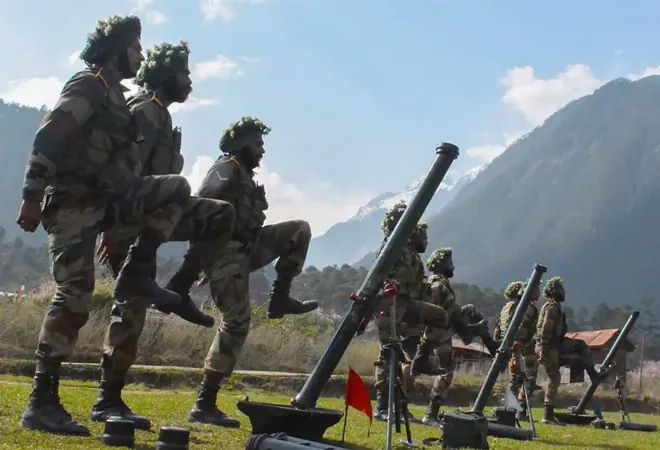
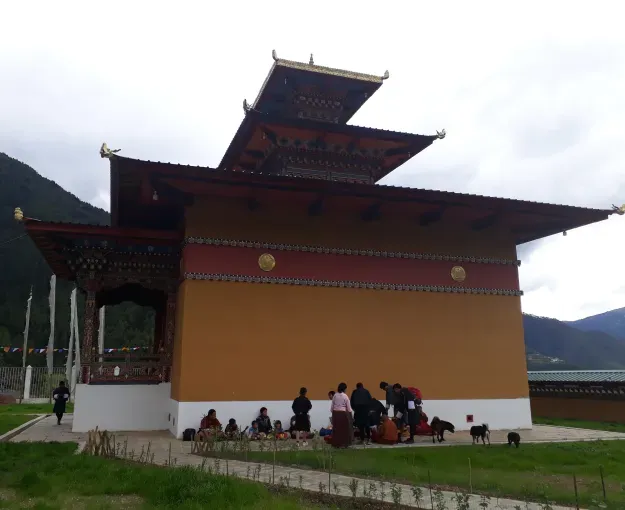
Chhundu Lhakhang
Activity: Visit a temple dedicated to Haa’s protective deity.
Details: This sacred temple is dedicated to Ap Chhundu, the guardian deity of Haa. Set amidst scenic surroundings, the temple is a place of worship and an important cultural landmark in the valley. Visitors can learn about the local beliefs and legends associated with this revered deity.
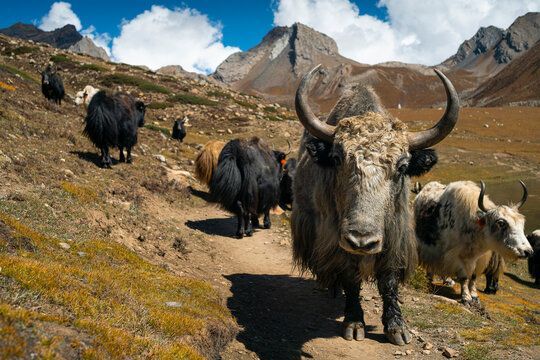
Yak Herder Encounters
Activity: Experience the life of nomadic yak herders.
Details: Haa’s high-altitude pastures are home to yak herders who maintain a traditional nomadic lifestyle. Visitors can interact with herders, learn about their practices, and taste products like yak cheese and butter. This unique experience offers a glimpse into a way of life that has remained unchanged for generations.
Wangdue Phodrang: Gateway to Central Bhutan
Wangdue Phodrang, located in central Bhutan, is a district known for its diverse landscapes, ranging from subtropical valleys to high-altitude pastures. It serves as a gateway to central Bhutan and offers a mix of cultural landmarks, natural beauty, and traditional lifestyles. Wangdue Phodrang is a destination where visitors can immerse themselves in Bhutan’s history and natural charm.
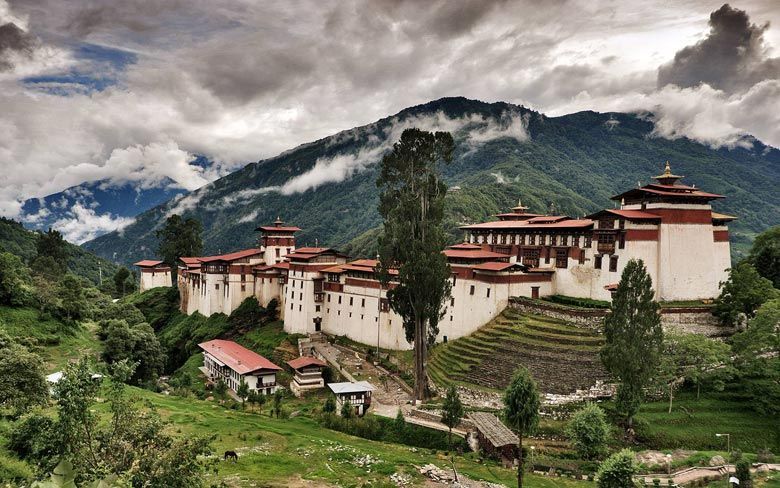
Wangdue Phodrang Dzong
Activity: Visit a historic fortress under reconstruction.
Details: Perched on a ridge overlooking the Punatsangchhu River, Wangdue Phodrang Dzong was originally built in 1638 by Zhabdrung Ngawang Namgyel. Though damaged by fire in 2012, the dzong is undergoing restoration. Visitors can admire its architectural splendor and learn about its historical significance.
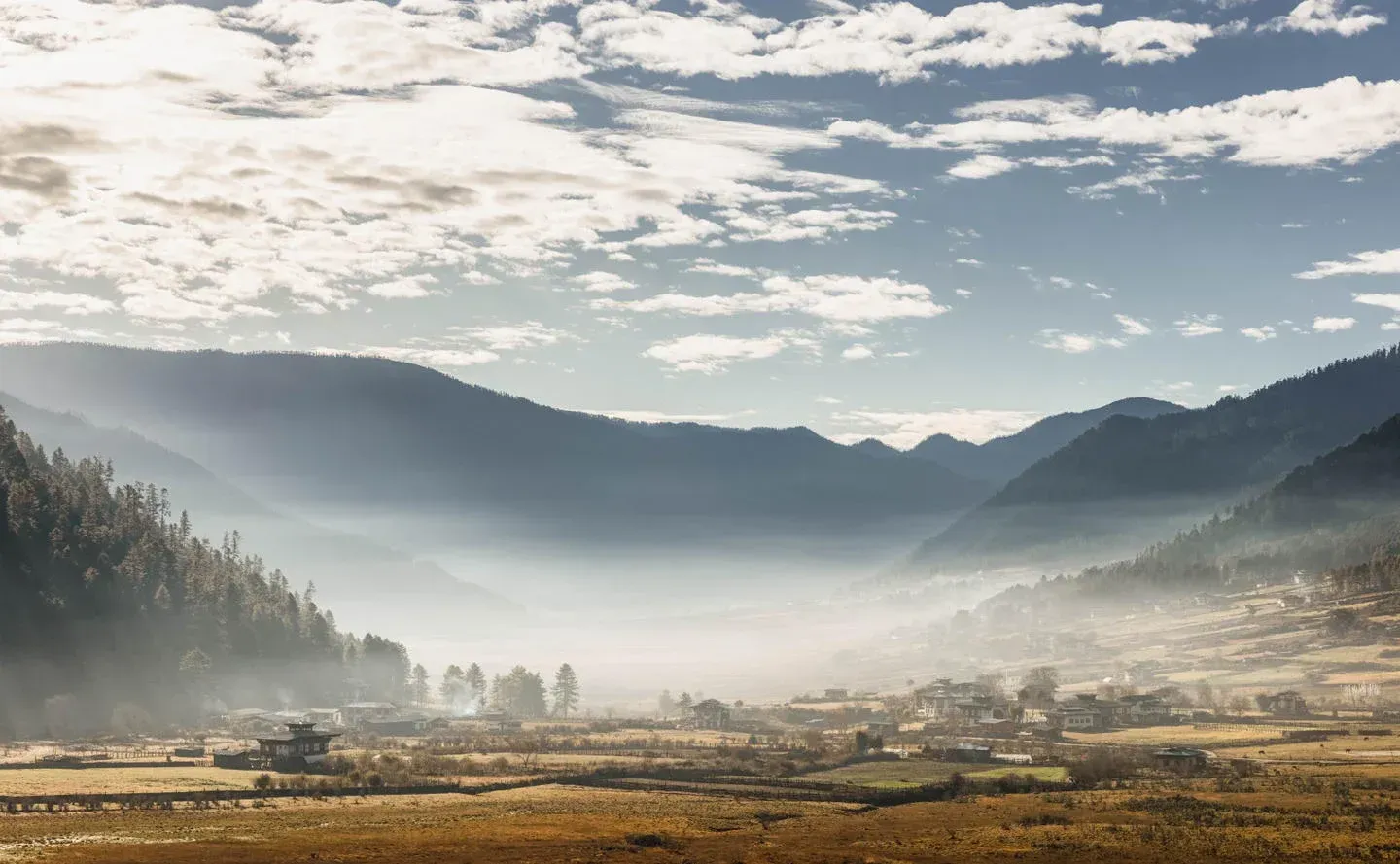
Gangtey (Phobjikha) Valley
Activity: Explore Bhutan’s stunning glacial valley.
Details: The Gangtey Valley, often called the “Valley of Black-Necked Cranes,” is a haven of natural beauty. Visitors can enjoy the serene landscape, spot the endangered black-necked cranes during their winter migration (October to March), and visit charming villages scattered throughout the valley.
Gangtey Monastery
Activity: Visit an important Nyingma monastery.
Details: Situated atop a hill overlooking the Phobjikha Valley, Gangtey Monastery is one of Bhutan’s most important Nyingma religious sites. Visitors can explore its serene courtyard, interact with monks, and enjoy panoramic views of the valley below.
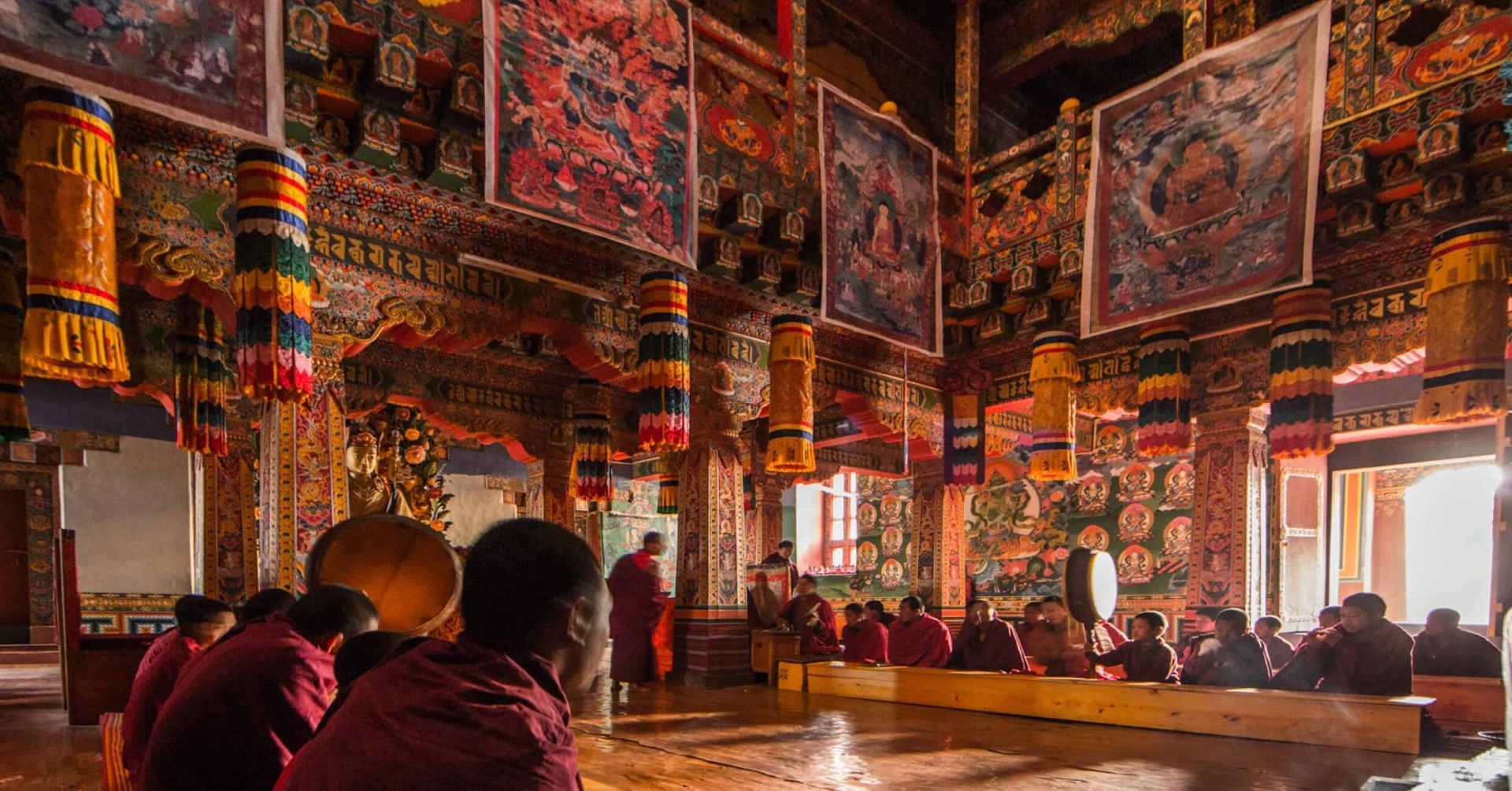
Phobjikha Nature Trail
Activity: Take a leisurely hike through the valley.
Details: The Phobjikha Nature Trail is a gentle 1.5-hour hike that meanders through forests, meadows, and local villages. It offers stunning views of the valley and opportunities to observe the black-necked cranes during their migration season.
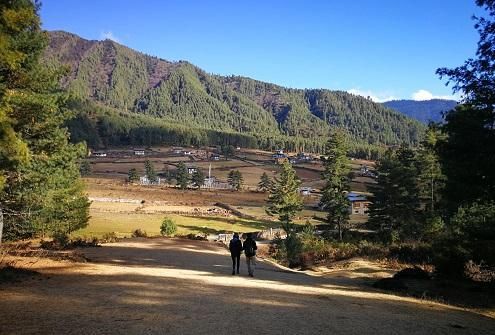
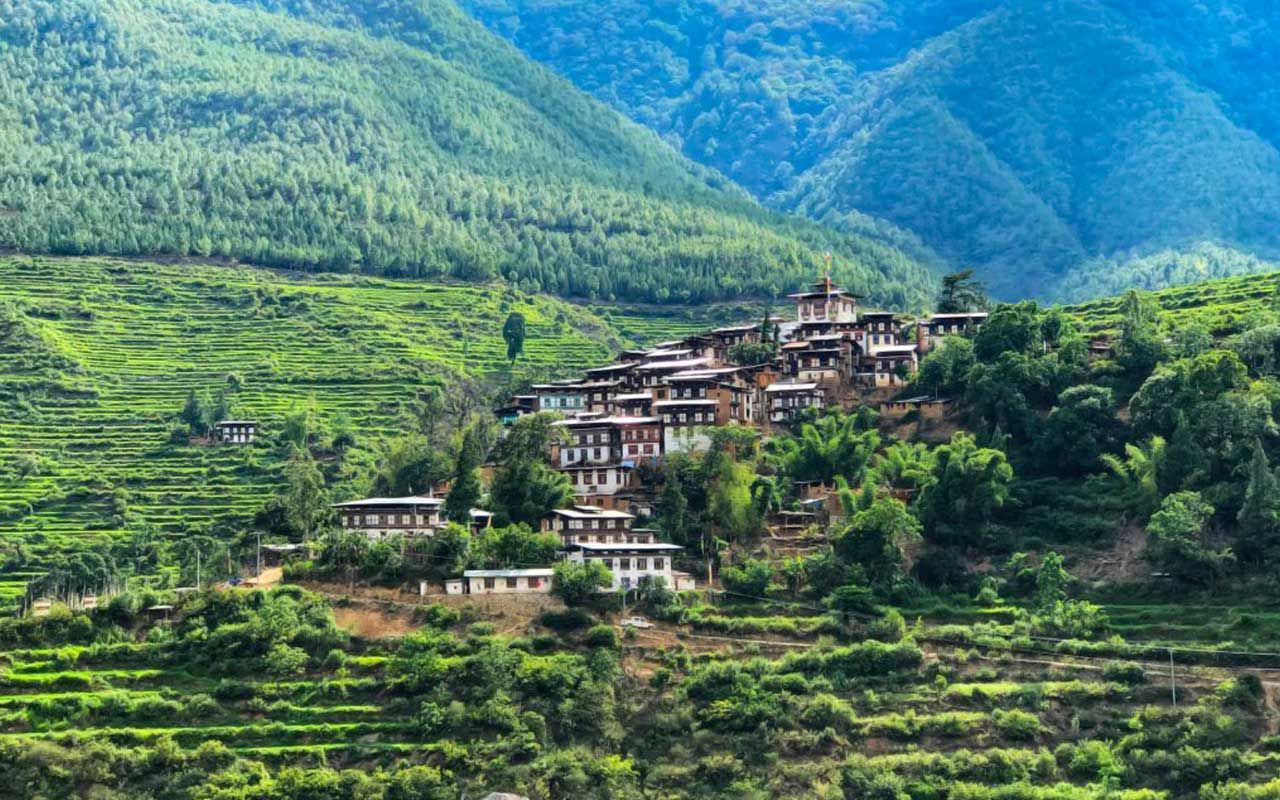
Rinchengang Village
Activity: Discover a traditional Bhutanese village.
Details: Located near the Wangdue Dzong, Rinchengang Village is one of the oldest settlements in Bhutan. Visitors can explore the village’s traditional mud-brick houses and interact with locals, gaining insight into rural Bhutanese life.
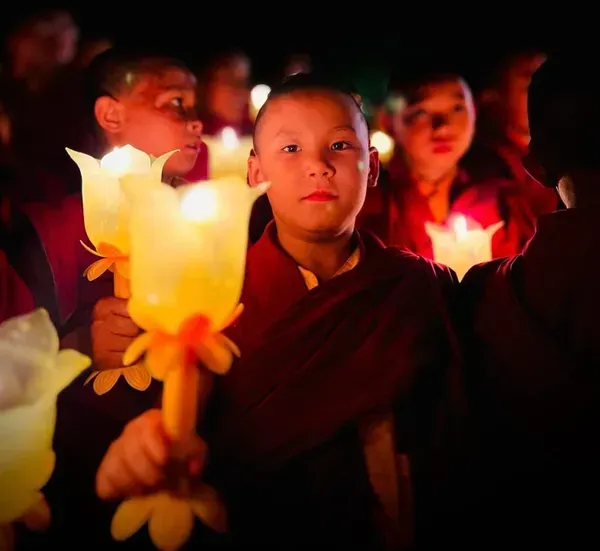
Rinchenling Gonpa
Activity: Visit a secluded monastery.
Details: Located in a remote area, Rinchenling Gonpa offers a peaceful retreat for visitors. The monastery’s serene atmosphere and surrounding natural beauty make it a perfect spot for meditation and quiet reflection.
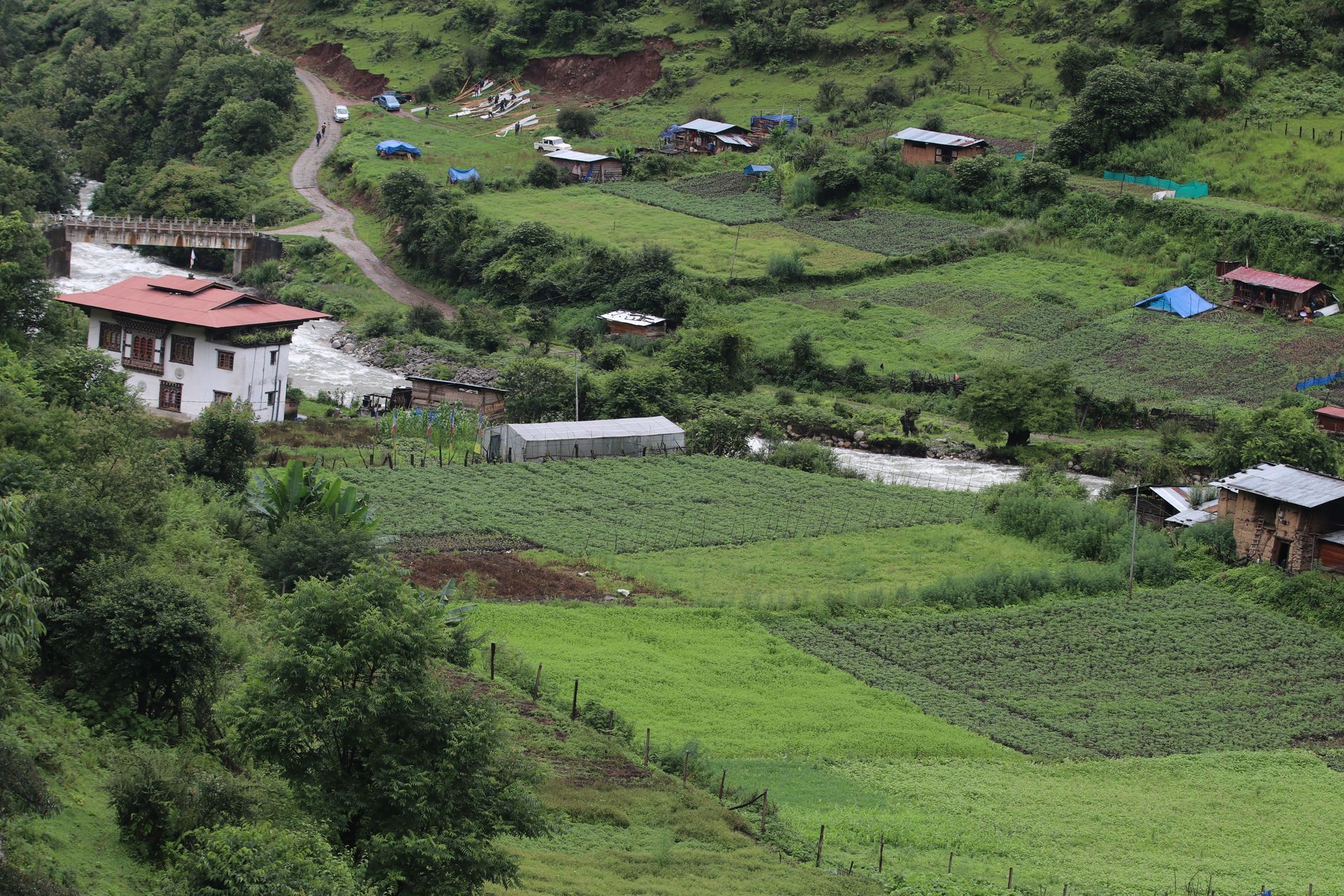
Dangchu Valley
Activity: Explore an idyllic valley off the beaten path.
Details: Dangchu Valley is known for its picturesque villages, terraced fields, and vibrant culture. Visitors can enjoy nature walks, visit local homes, and experience the traditional lifestyle of the valley’s residents.
Black-Necked Crane Information Center
Activity: Learn about Bhutan’s cherished migratory birds.
Details: Located in Phobjikha, this center provides educational exhibits on the endangered black-necked cranes. Visitors can use the observation deck to view the cranes in their natural habitat during the migration season and learn about conservation efforts in the area.
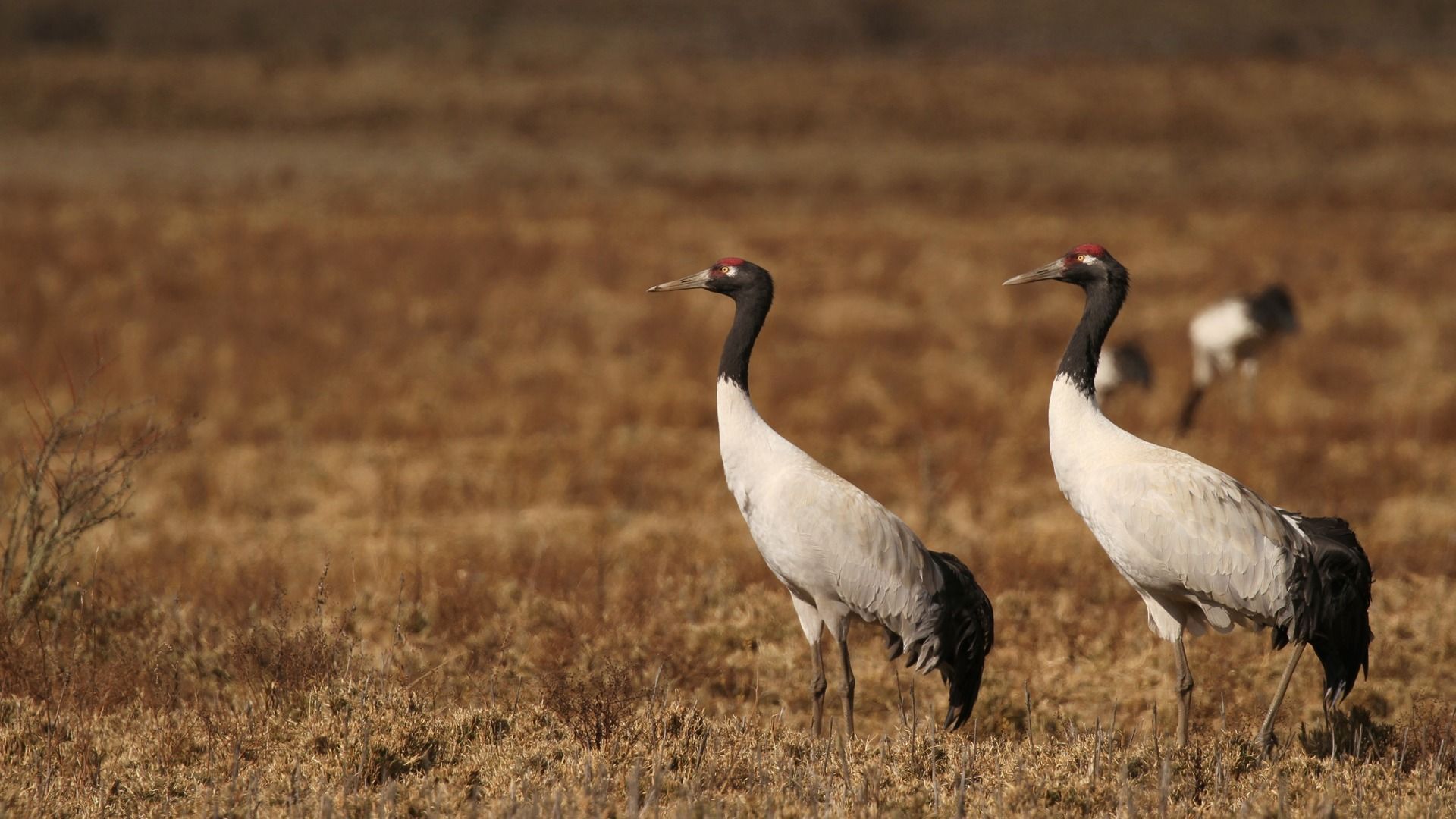

River Rafting on Punatsangchhu
Activity: Enjoy an exhilarating water adventure.
Details: The Punatsangchhu River offers exciting rafting opportunities suitable for all skill levels. The journey combines mild rapids with serene stretches, allowing visitors to enjoy both adventure and the scenic beauty of the Wangdue valley.
Mongar: The Gateway to Eastern Bhutan
Mongar, a charming district in eastern Bhutan, serves as the gateway to the eastern regions of the country. Known for its scenic beauty, traditional weaving, and welcoming locals, Mongar offers visitors a blend of cultural experiences and natural attractions. The district is characterized by lush forests, rolling hills, and a rich cultural heritage that makes it a must-visit destination in Bhutan.
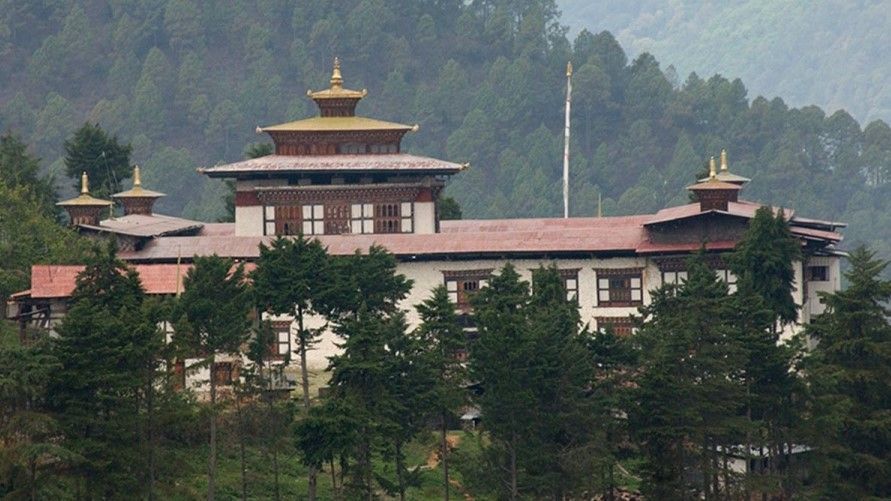
Mongar Dzong
Activity: Visit a modern yet traditional fortress.
Details: Mongar Dzong is one of Bhutan’s newer fortresses, built in 1953 using traditional architectural techniques. It’s an administrative and religious center that reflects Bhutan’s unique dzong architecture, with no nails used in its construction. Visitors can explore the dzong and enjoy stunning views of the surrounding valley.
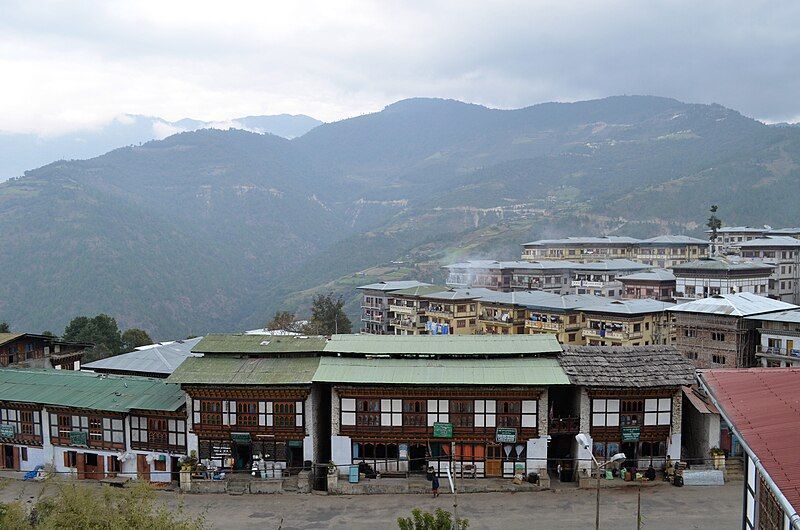
Yadi Loops
Activity: Experience a scenic drive through winding roads.
Details: The Yadi Loops, a series of 11 hairpin bends, offer breathtaking views of the surrounding landscapes. This stretch of road is a highlight for travelers journeying to Mongar, showcasing the district’s natural beauty and engineering marvels.
Lhuntse Weaving Villages
Activity: Explore the art of traditional Bhutanese weaving.
Details: Although located in the neighboring district of Lhuntse, the weaving villages are a short trip from Mongar and are renowned for producing Bhutan’s finest textiles. Visitors can watch skilled artisans at work and purchase vibrant handwoven fabrics as souvenirs.
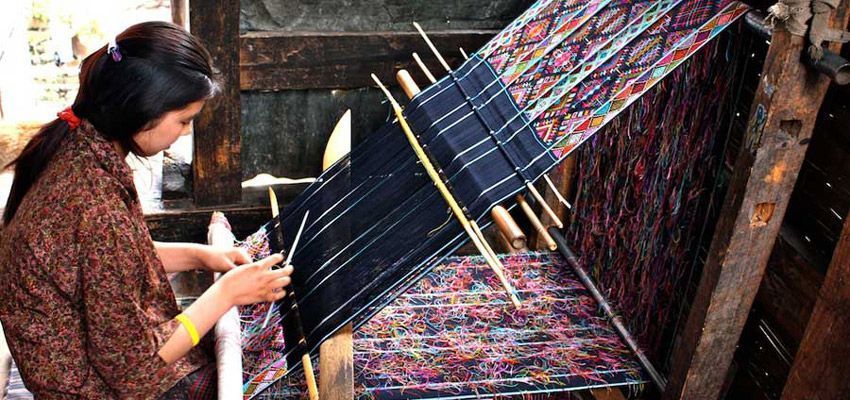
Drametse Monastery
Activity: Discover a sacred cultural landmark.
Details: Drametse Monastery, founded in the 16th century, is a revered Nyingma monastery known for its spiritual significance. It is also the birthplace of the famous Drametse Ngacham, a traditional mask dance included in UNESCO’s list of Intangible Cultural Heritage. Visitors can explore the monastery’s sacred halls and learn about its rich history.

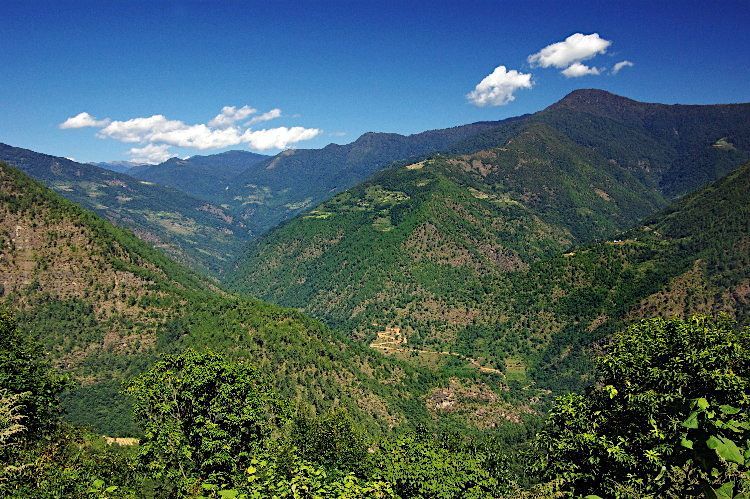
Korila Pass
Activity: Enjoy panoramic views from a high-altitude pass.
Details: Located at 2,450 meters above sea level, Korila Pass offers sweeping views of Mongar’s lush valleys and distant mountain ranges. The pass is adorned with prayer flags and serves as a peaceful stop for travelers to soak in the natural beauty.
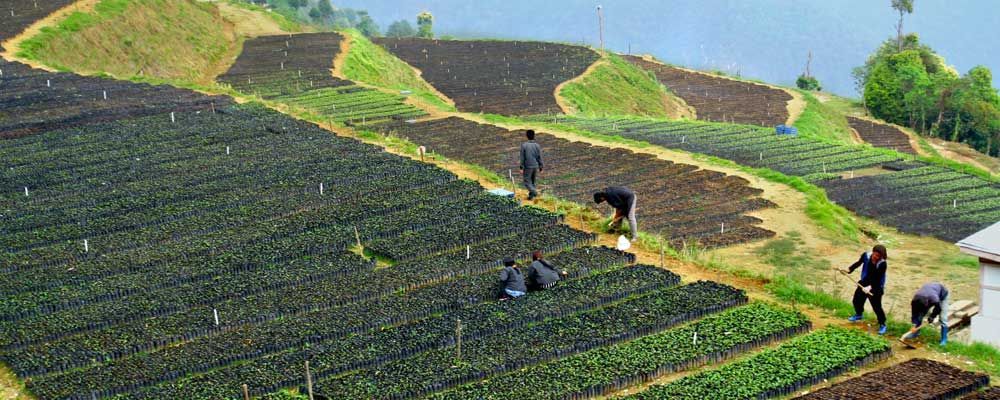
Lingmethang Valley
Activity: Discover a picturesque valley.
Details: Lingmethang is a tranquil valley known for its terraced fields, traditional farmhouses, and pristine environment. Visitors can take leisurely walks, interact with local farmers, and enjoy the serenity of rural Bhutan.
Mongar Tsechu (Festival)
Activity: Witness a vibrant cultural celebration.
Details: Held annually in the autumn, the Mongar Tsechu is a lively festival featuring traditional mask dances, music, and rituals. It’s an opportunity to experience Bhutanese spirituality and culture while mingling with friendly locals.
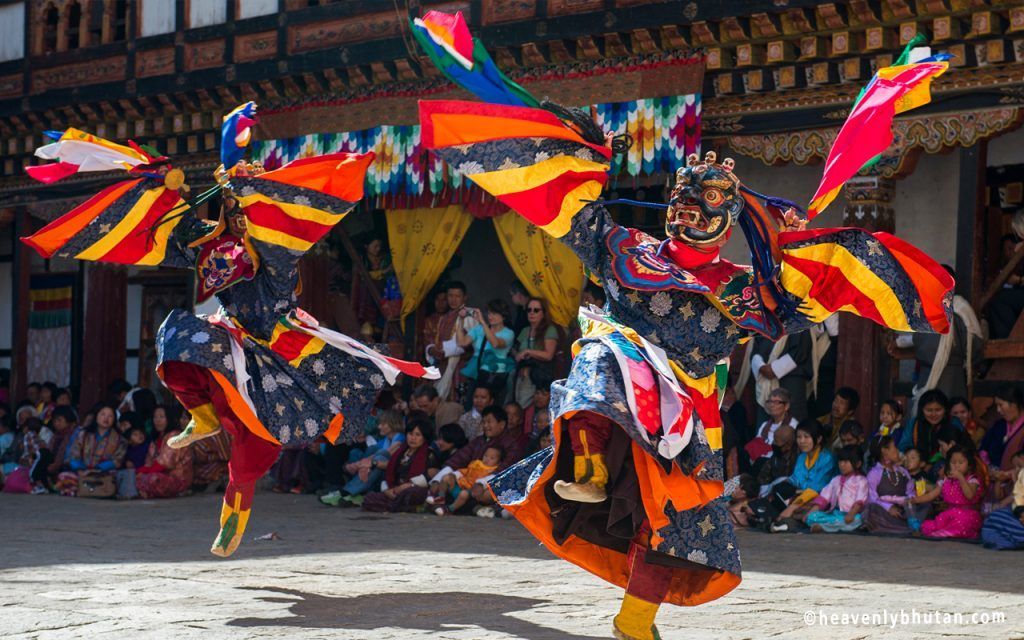
Nature Walks and Birdwatching
Activity: Explore Mongar’s rich biodiversity.
Details: The forests around Mongar are home to diverse flora and fauna, making it an ideal destination for nature walks and birdwatching. Visitors can spot colorful bird species and enjoy the peaceful surroundings of Bhutan’s eastern hills.
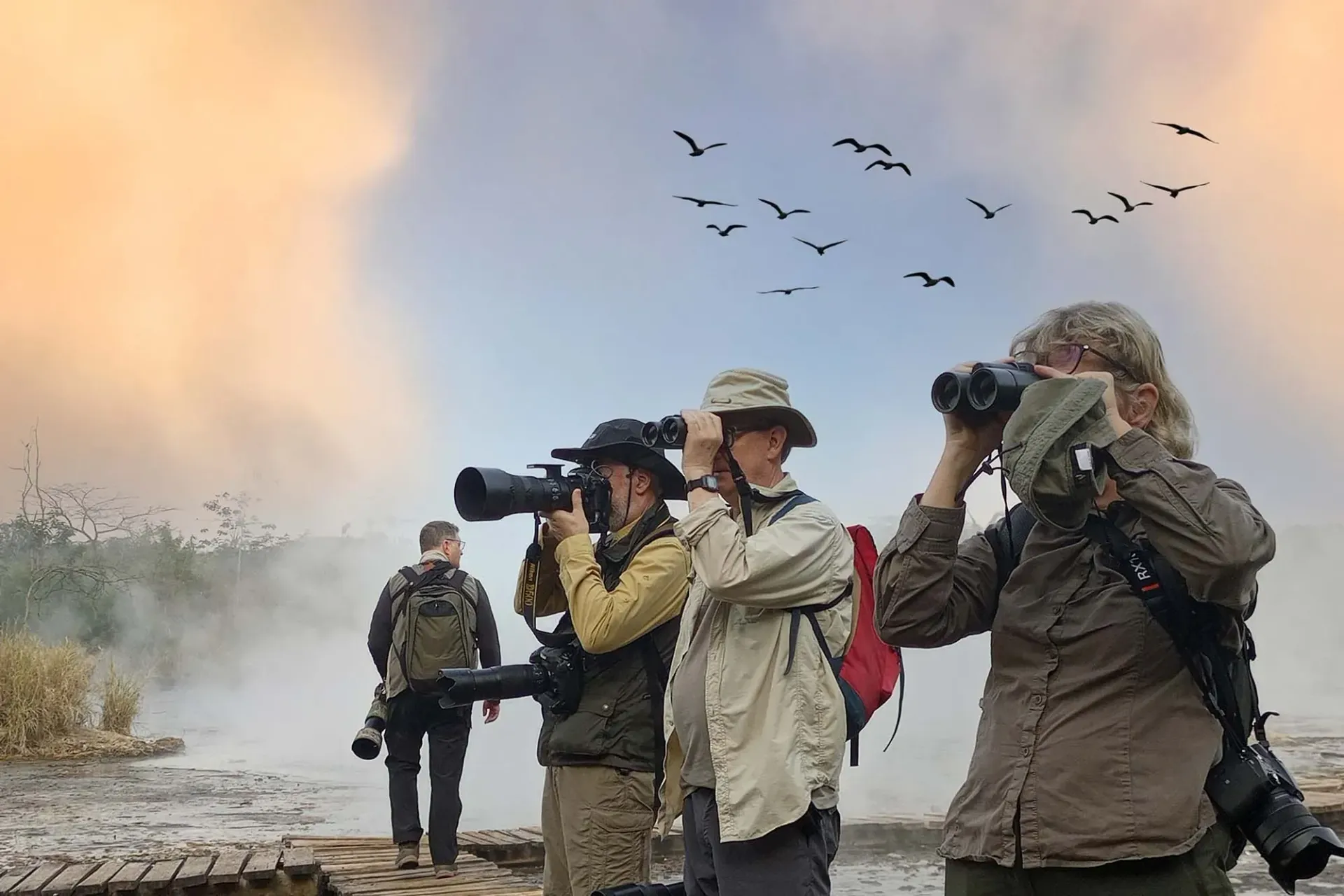
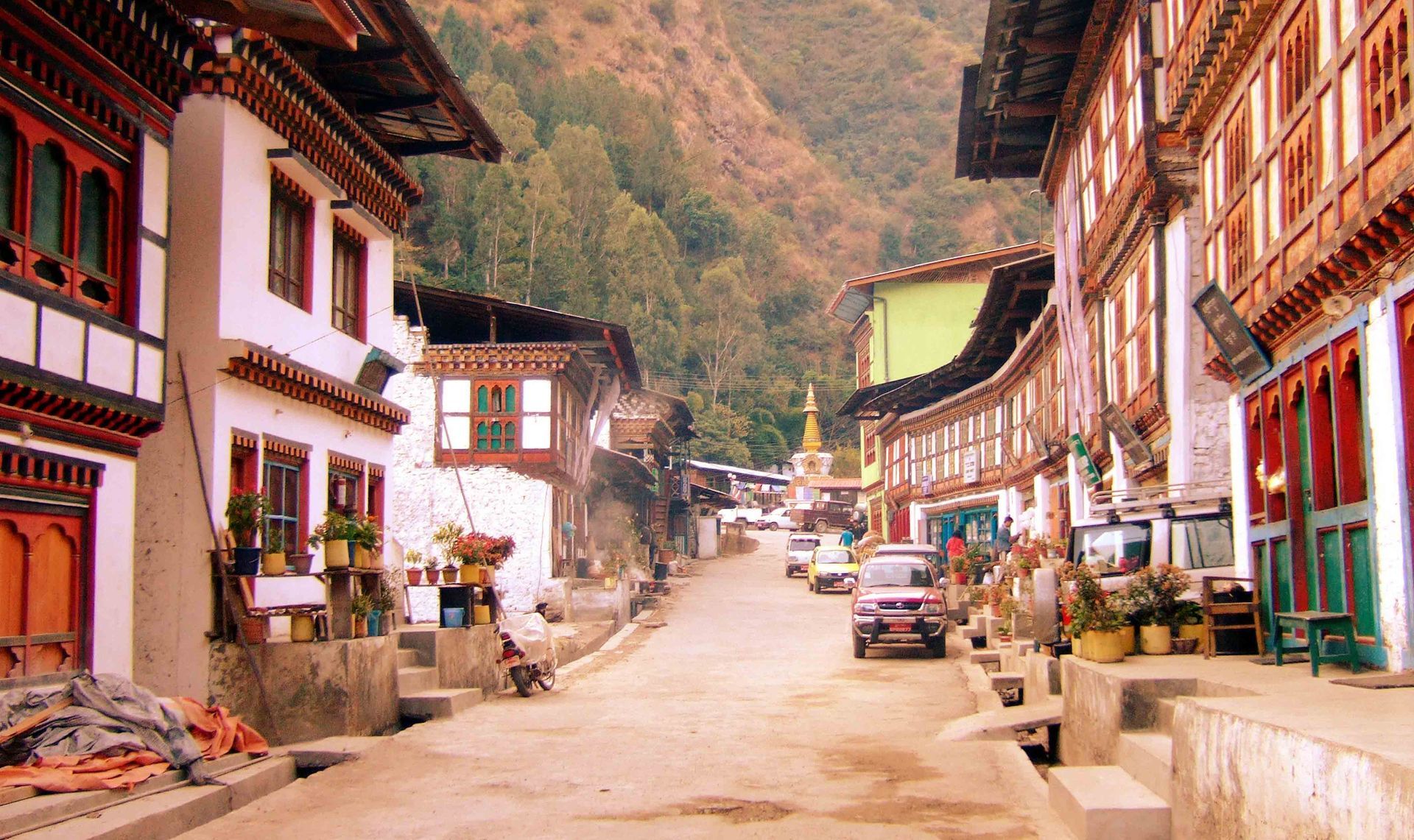
Trashigang Excursion
Activity: Extend your journey to a neighboring district.
Details: A short drive from Mongar, Trashigang is a bustling eastern district known for its vibrant markets and the historic Trashigang Dzong. Visitors can explore the dzong and enjoy the lively atmosphere of the town.
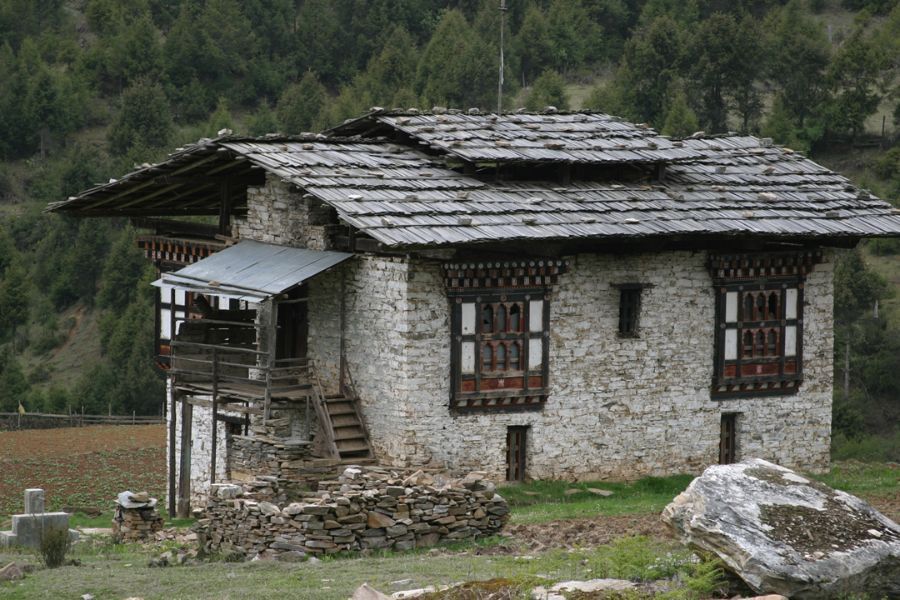
Rural Homestay Experience
Activity: Immerse yourself in traditional Bhutanese life.
Details: Stay in a traditional farmhouse and experience the warmth of Bhutanese hospitality. Guests can participate in daily activities like farming, cooking, and weaving while enjoying home-cooked meals made with fresh, organic ingredient
Trashigang: The Jewel of Eastern Bhutan
Trashigang, the largest district in Bhutan, is often referred to as the "Jewel of the East." Nestled amidst rolling hills and picturesque landscapes, Trashigang serves as a vibrant cultural hub for the eastern regions. Known for its historic dzong, bustling markets, and traditional lifestyles, this district offers a mix of cultural immersion and scenic beauty.
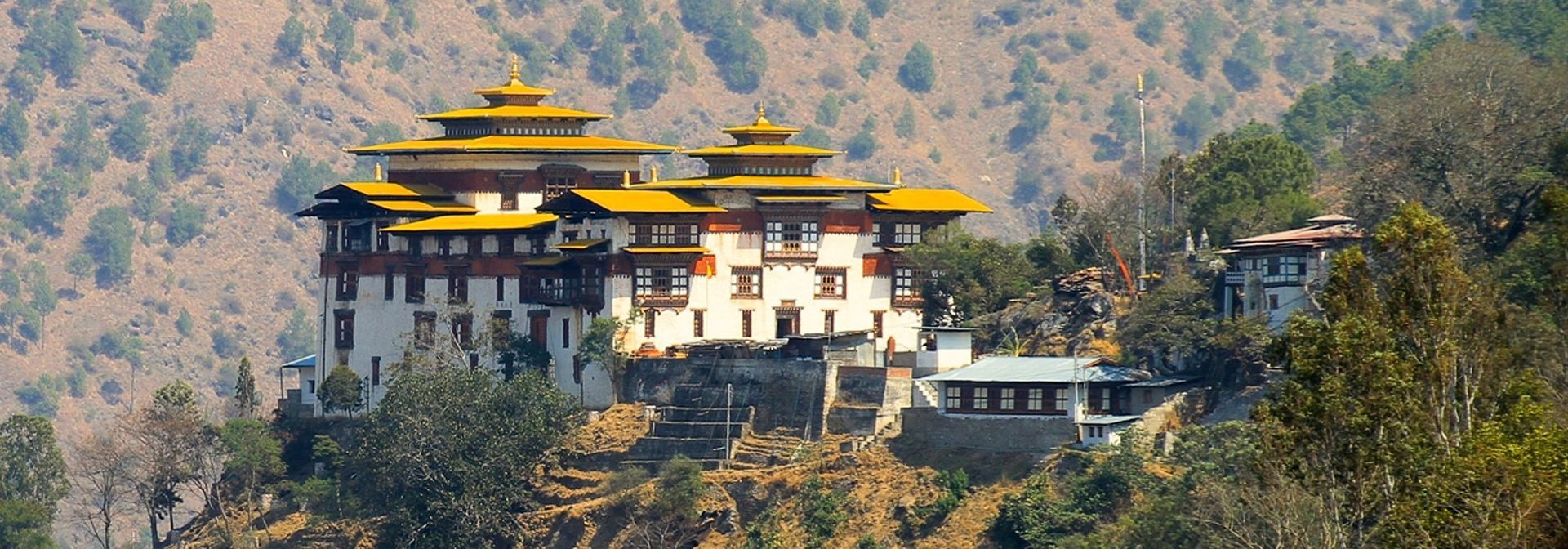
Trashigang Dzong
Activity: Explore a historic fortress with panoramic views.
Details: Perched on a cliff overlooking the Drangme Chhu River, Trashigang Dzong was built in 1659 to defend against Tibetan invasions. The dzong is an administrative and religious center and offers visitors a glimpse into Bhutan’s rich history while providing stunning views of the valley below.
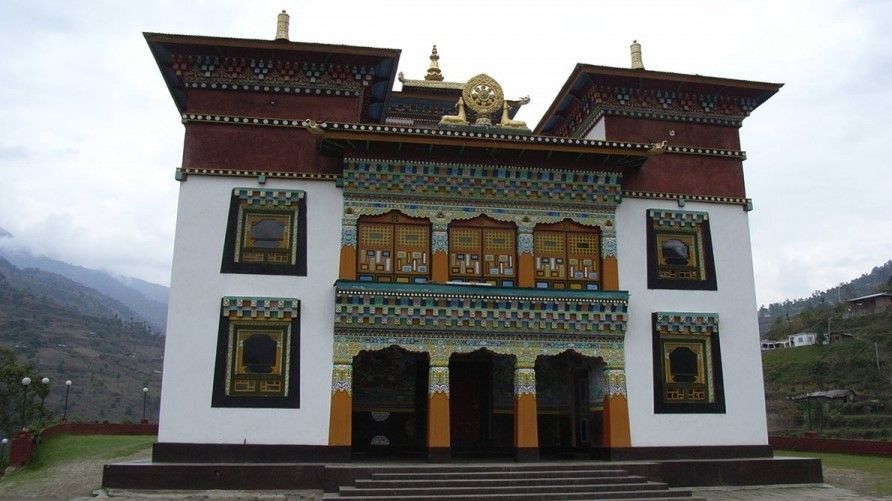
Rangjung Woesel Choeling Monastery
Activity: Visit a revered Buddhist monastery.
Details: Located in the town of Rangjung, this monastery is a significant religious site for the eastern region. Founded by Garab Rinpoche, it is a spiritual retreat and training center for monks. Visitors can explore the serene grounds and learn about the monastery’s teachings and practices.
Khaling National Handloom Centre
Activity: Discover the art of traditional weaving.
Details: A short drive from Trashigang, the Khaling Handloom Centre is dedicated to preserving Bhutan’s traditional weaving techniques. Visitors can observe skilled artisans at work and purchase intricate handwoven textiles, such as the famous "kira" and "gho" fabrics.

Gom Kora Temple
Activity: Visit a sacred site steeped in legend.
Details: Gom Kora Temple is a revered pilgrimage site along the Drangme Chhu River. It is believed that Guru Rinpoche meditated here, leaving an imprint on a rock. The temple is surrounded by lush fields and offers a tranquil environment for reflection.
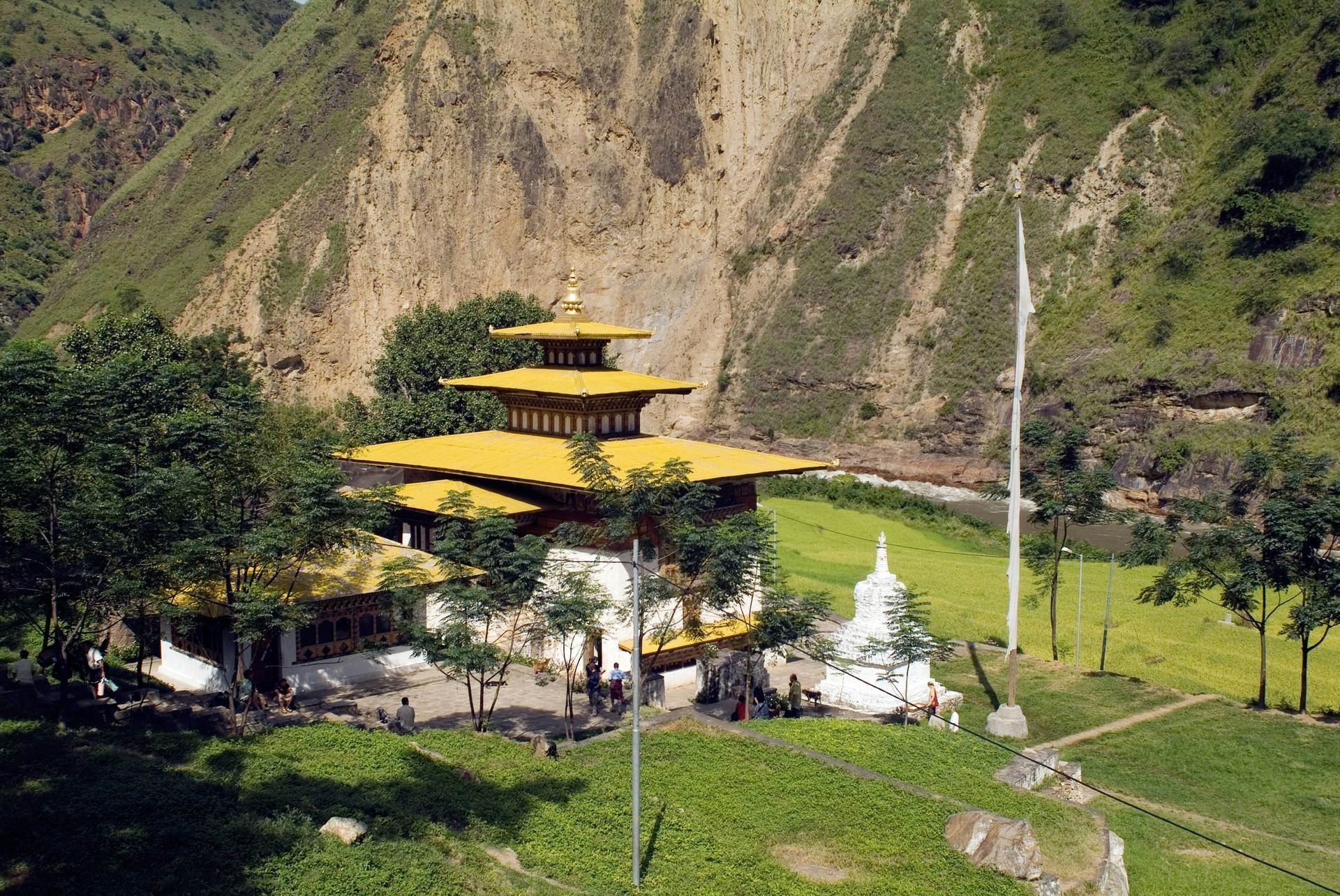
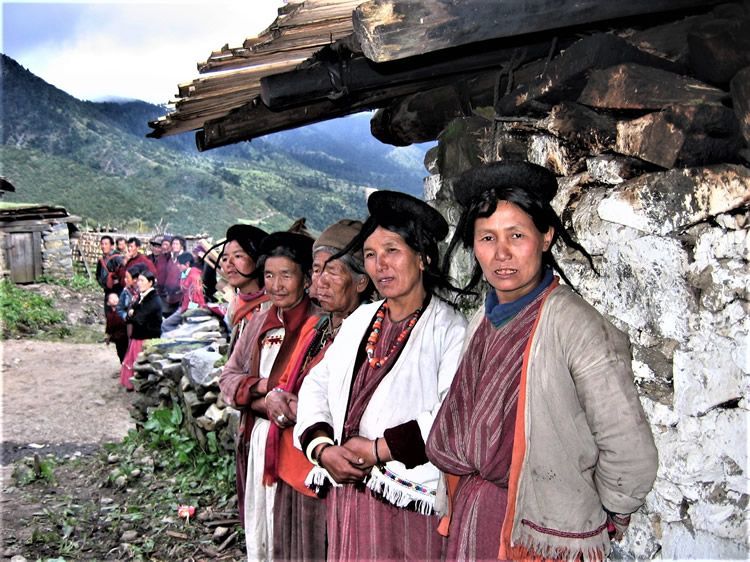
Merak and Sakteng Villages
Activity: Experience the unique culture of the Brokpa community.
Details: These remote highland villages are home to the semi-nomadic Brokpa people. Visitors can immerse themselves in their distinct traditions, attire, and lifestyle. Trekking to Merak and Sakteng offers breathtaking views of the rugged eastern landscapes.
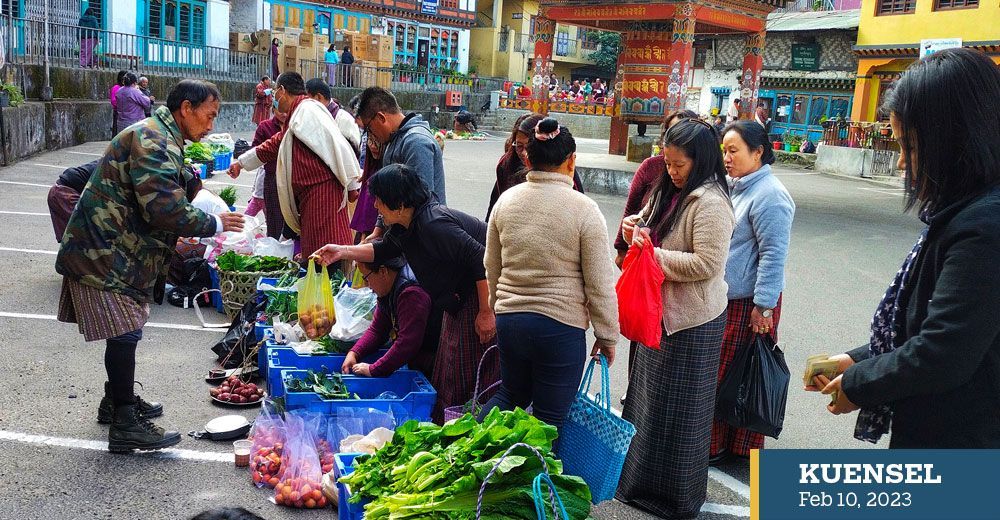
Trashigang Market
Activity: Shop at a vibrant local market.
Details: The market is a bustling hub where locals gather to trade goods and produce. Visitors can explore stalls selling fresh vegetables, traditional Bhutanese spices, handmade crafts, and textiles, offering a glimpse into daily life in the east.
Sakteng Wildlife Sanctuary
Activity: Explore a biodiversity hotspot.
Details: Sakteng Wildlife Sanctuary is home to diverse flora and fauna, including the elusive red panda. Visitors can enjoy guided nature walks, birdwatching, and exploring the sanctuary’s pristine landscapes. It is also intertwined with local legends, including tales of the mythical Yeti.
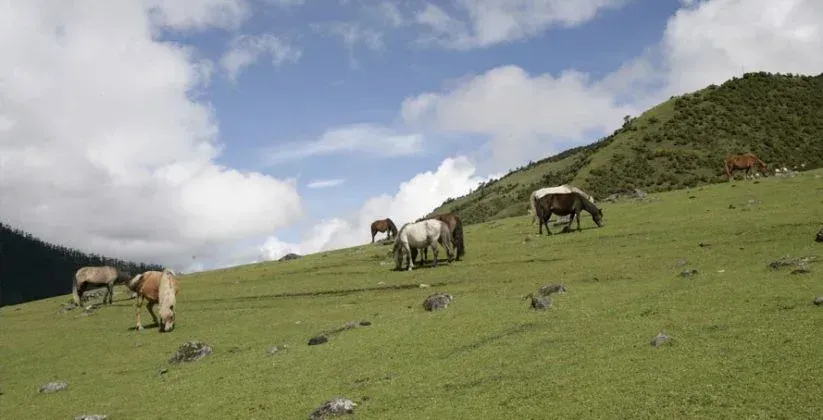
Drametse Monastery
Activity: Visit a UNESCO-recognized cultural site.
Details: Located a short distance from Trashigang, Drametse Monastery is renowned for its spiritual significance and the famous Drametse Ngacham, a mask dance inscribed on UNESCO’s Intangible Cultural Heritage list. Visitors can explore the monastery and learn about its religious practices.

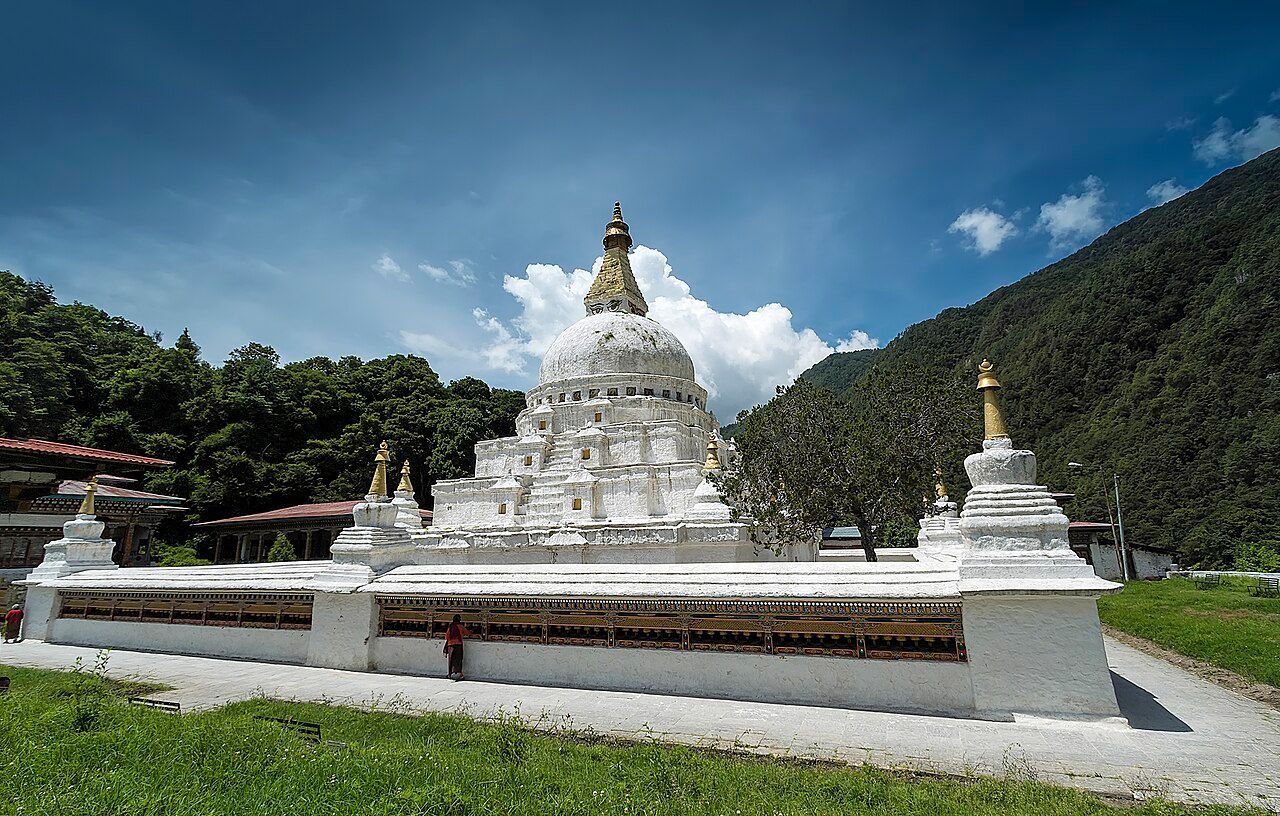
Chorten Kora in Trashiyangtse
Activity: Extend your journey to a sacred stupa.
Details: A day trip to nearby Trashiyangtse brings visitors to Chorten Kora, a stunning white stupa modeled after Nepal’s Boudhanath Stupa. The site hosts annual festivals where pilgrims gather for spiritual blessings and circumambulations.
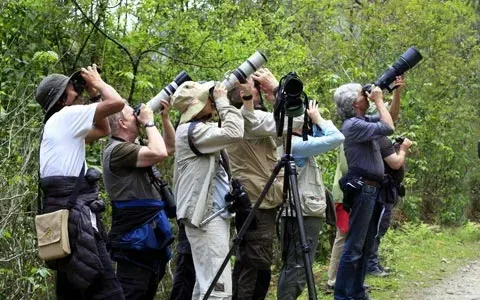
Birdwatching in the Drangme Chhu Valley
Activity: Spot exotic bird species in their natural habitat.
Details: The valley around Trashigang is a paradise for birdwatchers, with sightings of rare species such as the black-necked crane, rufous-necked hornbill, and Himalayan monal. Guided birdwatching tours provide a chance to connect with nature and explore the region’s biodiversity.
Lhuentse: The Ancestral Home of Bhutanese Royalty
Lhuentse, located in northeastern Bhutan, is one of the country’s most remote and culturally significant districts. Known as the ancestral home of Bhutan’s royal family, it boasts dramatic landscapes, sacred temples, and a rich tradition of textile weaving. Visitors to Lhuentse can immerse themselves in Bhutan’s authentic rural charm and spiritual heritage.
Lhuentse Dzong
Activity: Explore an iconic fortress perched on a hill.
Details: Lhuentse Dzong, built in the 17th century, is an architectural marvel overlooking the Kurichhu River. It serves as an administrative and monastic center, offering visitors a glimpse into Bhutan’s historical and spiritual legacy. The dzong’s dramatic setting and serene ambiance make it a must-visit site.

Khoma Village
Activity: Discover the art of Kishuthara weaving.
Details: Khoma Village is renowned for producing Bhutan’s most exquisite handwoven textiles, known as Kishuthara. Visitors can watch skilled artisans at work and purchase these intricately designed fabrics. The village offers a unique opportunity to learn about Bhutan’s rich textile heritage.
Takila Guru Statue
Activity: Visit one of the largest statues of Guru Rinpoche.
Details: The 154-foot-tall statue of Guru Padmasambhava at Takila is a magnificent spiritual landmark. Set amidst stunning landscapes, the site provides a serene environment for meditation and breathtaking views of the surrounding valleys.
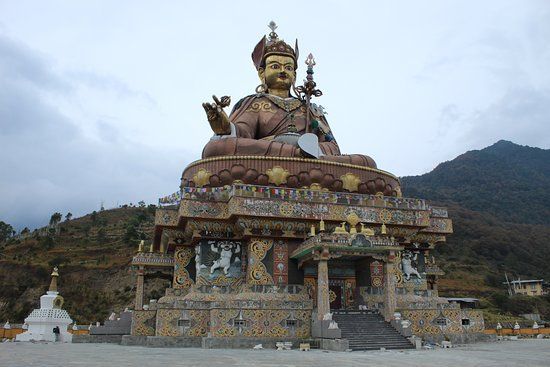
Singye Dzong Trek
Activity: Embark on a spiritual trek to a sacred site.
Details: Singye Dzong, one of Bhutan’s holiest pilgrimage sites, is located in the remote highlands of Lhuentse. The trek takes visitors through pristine forests, alpine meadows, and remote villages, culminating in a spiritually enriching experience at the sacred monastery.
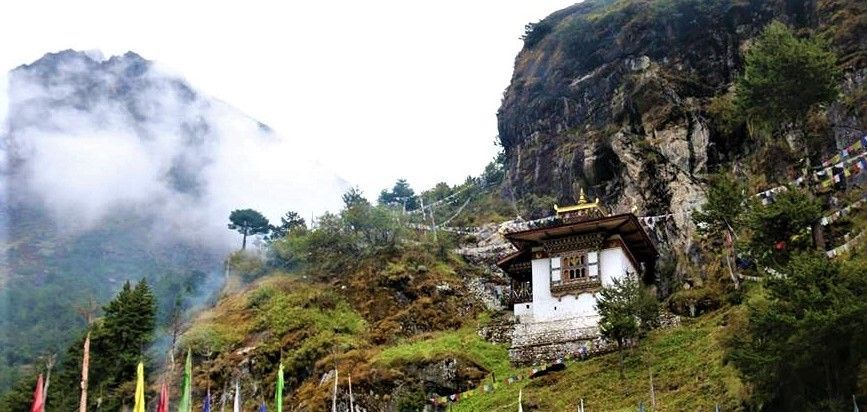

Nature Walks and Birdwatching
Activity: Explore Lhuentse’s diverse flora and fauna.
Details: The district’s forests and valleys are teeming with birdlife and native plants. Guided nature walks offer visitors a chance to connect with Bhutan’s pristine environment while spotting exotic bird species and enjoying the region’s natural beauty.
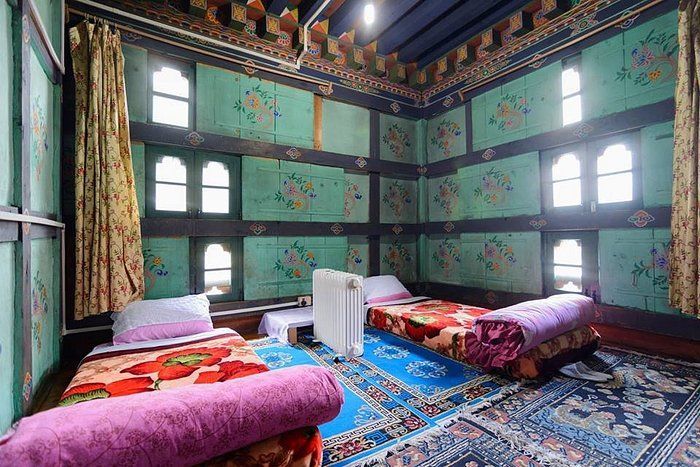
Remote Village Homestays
Activity: Immerse yourself in traditional Bhutanese life.
Details: Staying with a local family in a remote village provides a firsthand experience of Bhutanese hospitality and rural life. Guests can participate in farming activities, enjoy home-cooked meals, and learn about traditional customs and practices.
